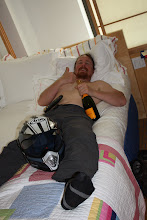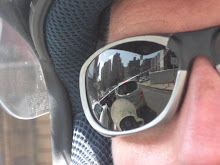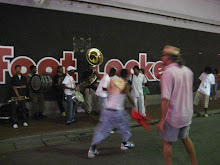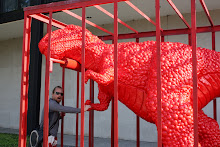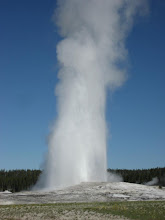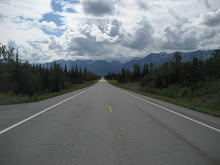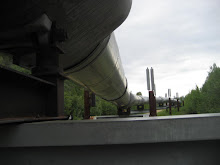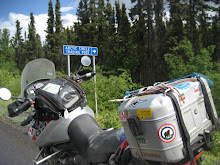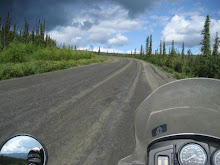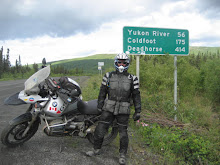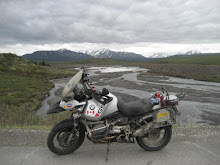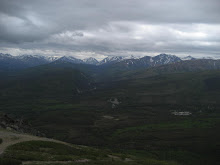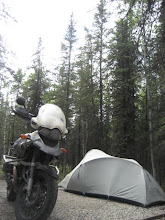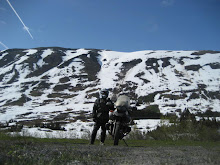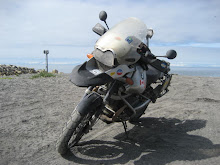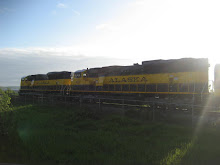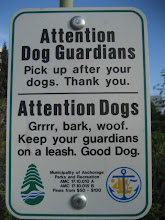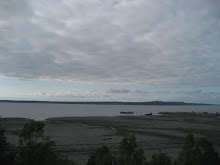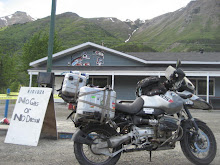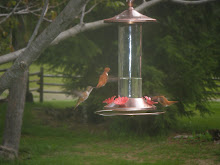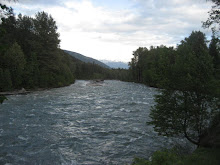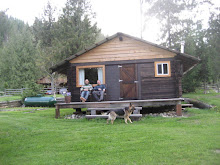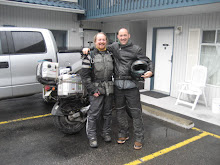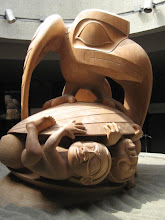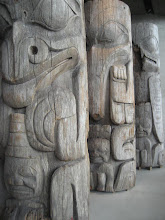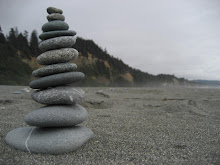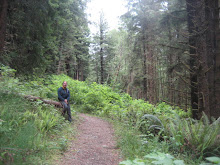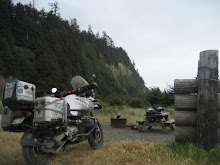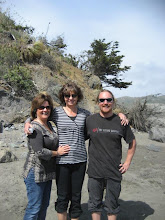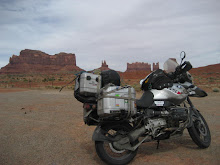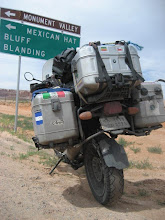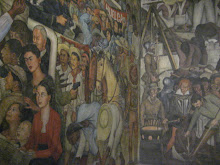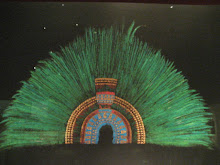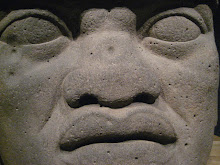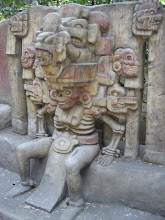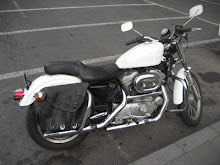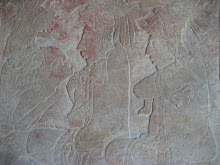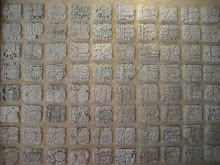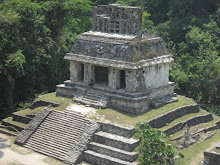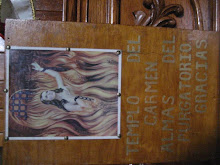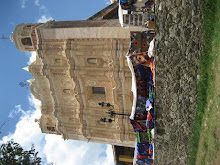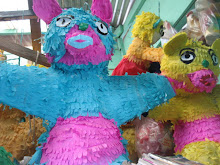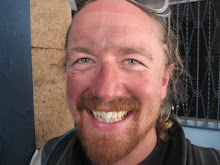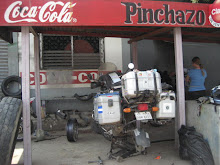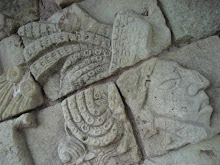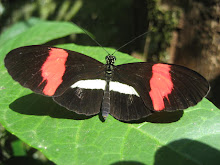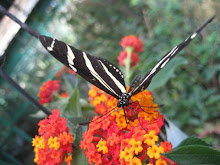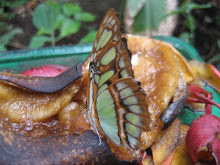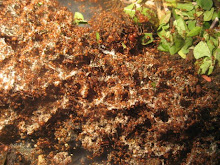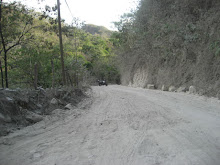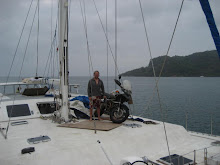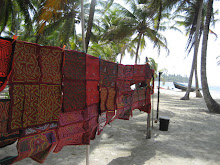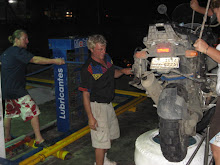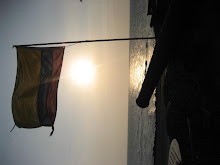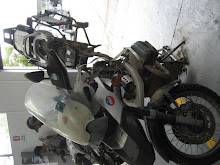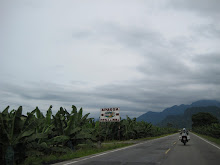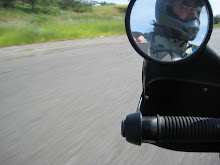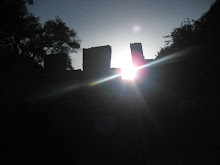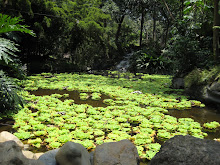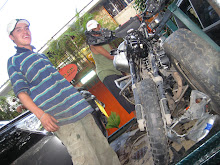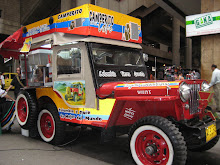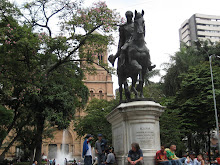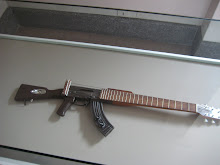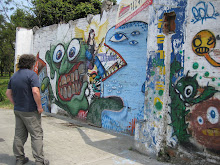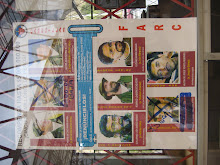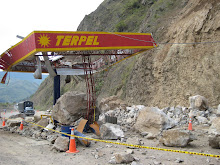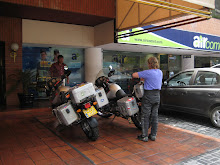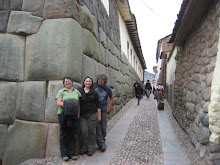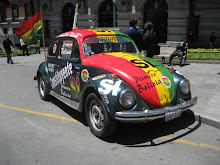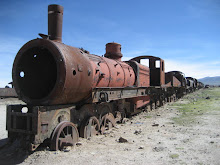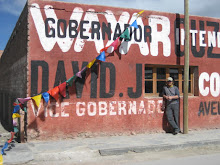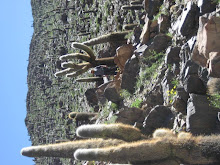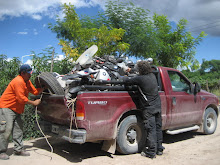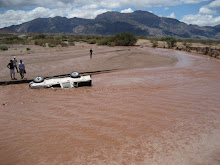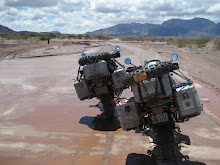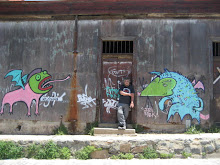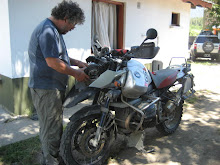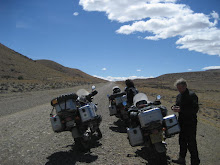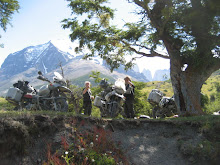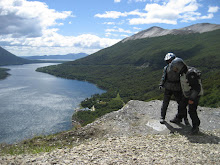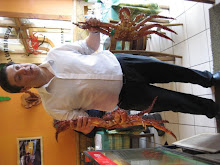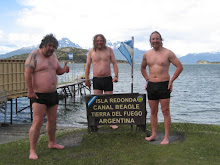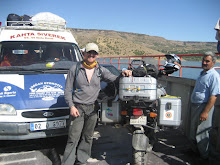On the way to Palenque we stopped off on the twisty, mountainous road to go swimming in Cascadas Agua Azul. It was delicious to get out of sweaty hot bike gear, exposing our sweaty, spongy flesh to the refreshing water and the gentle sun, filtered through the leaves and humidity of the jungle. Whilst twisty in sections, this was also The Road of Topes / Tumelos, (sleeping policemen), most of them locally made by those Chiapans living nearby. It was frustrating to have to keep slowing down, for no apparent reason in the middle of nowhere and with no signs or warnings. There were some signs saying you are now entering Zapatista Chiapas, Viva la Revolucion, etc, most probably left over from the period of several weeks a decade ago when the region claimed and effectively achieved independence under the balaclava - clad SubCommandante Marcos.
The road improved in the end, although increasingly surrounded by the electric hum of cicadas and the humidity of the jungle as it closed in on us as we descended towards the Caribbean. Onto the gates of Palenque National Park, avoiding the surprisingly large town, and we stayed in the Jungle Palace. It was a lovely setting as we parked amongst the trees and I got settled into a quiet isolated corner, next to the stream and recovered from the biggest bead - on since Bandar - e - Abbas in the gauze cube that would be my home for the next 2 nights. A combination of too much Bohemia and the noise of the jungle at night outside and scuttling and scurrying across the concrete floor of the hut, meant I was up before dawn. Listening to the ringing, chirping, buzzing, sawing, wailing and knocking of the early morning jungle noise, I decided to get up and walked and talked on the phone to my Mum and my brother and got ready to explore the ruins with Hamish and Emma, our last day together. They too had a bad night due to noisy neighbours and so we went back to sleep and went to the ruins in the heat of the day, when all the coaches had left. We had a great day, tramping over the impressive Mayan site and soaking in the relaxing, if hot and sweaty atmosphere together.
Hamish and Emma are a great couple who shared a lot in common with Lena and I. Hamish and I got on very well as he was always keen for a cool beer and Emma was a unique person too, always having an interesting perspective on things. For instance, she was wearing a balaclava under her helmet in the Mayan jungle, Commandante Marcos style, and when I first met her in Medellin, she offered me some delicious sprouting beans that she was growing in a plastic pot in her pocket - all whilst on a motorcycle adventure trip through Latin America. They were Ex Pats, having lived in Malaysia and both enjoyed writing; we could share stories about some of the places we had travelled to and people we had met (on this trip and before) and motorbikes of course. Still by the end of our time together at Palenque I am ready to get going by myself again. I am confident we all had a great time together in Central America and Southern Mexico, which is pretty remarkable really given we were initially strangers having only met briefly in Medellin beforehand. I sensed in myself over the last few days, a feeling which I believed was reciprocated by Hamish and Emma, that we were all anxious to resume our trips at our own pace, without the added logistical difficulties and inevitable individual compromises that travelling in a group, even a small one entails. They have become firm friends and I will definitely keep in touch with them and hope to meet up with them in the UK over the summer when we are all back and hopefully beyond that too.
Palenque was remarkable for its setting amidst the jungle, throbbing with life, like the skittish lizards with a fin fan thingy across their heads and the striped toucans, both of which would thrash through the vegetation on your arrival into a quiet glade on the heavily wooded northern sections of the ruins. Also, the similarities with ancient Asian, particularly Chinese, archeological sites was striking to me. The prolific use of cinnabar red and jade green, the creation of jade death masks and the employment of terraced pavilions along with the almond eyes of the Mayan figures depicted in the statues and friezes. The whole site was on a grander scale than Copan and the musuem highlighted some interesting exhibits and facts, like the fact that Venus was the God of War for the Mayans. This, and a lot of other interesting facts, were all revealed because the Mayans, unlike the Incas of Peru, did have a glyphic writing system, which phonetically still sounds like the present day local dialect - Chotl. More remarkably still however, is that they could build on such scale and with such artistic detail with no metal tools, no wheel and no beasts of burden, just like the Incas.
After tramping around the jungle and getting back for a shower, I met Loiusana Steve and his dog, Pachunki, which was Chotl for stone. He invited me up to his place for a coffee. He was an interesting character who had retired from the US Navy twenty years ago and ended up in Mexico because of the cheaper cost of medical care than in the US. He was a cyclist and biker and we talked about routes, etc for a while, whilst Fox News played loudly from his home theatre system, oddly wrapped in plastic bin bags to protect it from the humidity of the jungle. It gradually became clearer to me that he had also left the US because he was a very right wing person politically, and was dissatisfied with the "liberal track the country had taken recently"! This included examples of how Taser parties were becoming more popular, according to Fox News. These electric shock guns are completely unregulated in the US, and apparently, those "liberals" who feel uncomfortable openly owning a gun, are increasingly attending parties run along the lines of Ann Summers or Tupperware parties, trying out the product and choosing various fashionable covers, like mobile phone covers, and holsters before making their purchase. Good ol' boy Steve, just couldn't understand why they didn't just buy a regular automatic weapon for godsakes!? I made my excuses and left. It was a shame that his bigotry had made me rush off as Pachunki was a great dog.
The Howler Monkeys were about again during the darkness of the pre-dawn, and after a charming dawn breakfast with Hamish and Emma, I got on the bike to go and realise they had been using my bike as high - altitude target practice, crapping on bike from above. Charming! Again, another dubious guidebook statistic says that they are the largest primate in the Western Hemisphere. They may actually be bigger than the Mayans in their local area, but they are certainly not bigger than the larger North American branch of the dominant Homo Sapiens Sapiens simian species. I realised during this period that I am developing a loner mentality and significantly start singing "One Man Guy" by Loudon Wainwright III to myself in my helmet - studio as I leave the jungle fastness of the Mayan kingdom for the mountains of Oaxaca and the Zacotec federation. First I have to sweep down close to the Caribbean between Villahermosa and Minantitlan. It was officially 38 degrees today and I use one of the stops at the expensive pay booths for the toll roads and put sun screen on but it was soon so hot again that it ran into my eyes, making my vision blurred. Just like the Howler Monkeys at dawn earlier that day, you could smell Mexico City before you could see it. Tired and with sore eyes from the baking heat and sun screen an daunted by the prospect of entering the heart of the largest city in the Americas on Friday rush hour, I stop in the nearby suburb city of Cordoba for the night.
Checking in at a hostal on the main square, I feel half deaf as well as half blind as I can barely understand the speed and accent of the lady who owns the place and is trying to direct me to the garage door at the back. There is definitely a faster, sing song and nasal Spanish in Mexico than I have been used to and it seems to be getting faster as I get closer to Mexico City. I take a stroll in the early evening and check out the old cathedral bells in the square from the old church that fell down, yep you guessed it, from an earthquake in the nineteenth century.
Mexico City is a great American City (certainly THE greatest American City in terms of its sheer size) and suffers from all the glories and shames of all its lesser cousins to the north and south. Poverty, crime, great architecture and food etc. Riding through the hillside townships, before descending into the smoggy valley of Tenochtitlan. This is where the legend of Quetzalcoatl is linked with the founding of the city, when an Aztec ancestor saw an eagle swoop down and take a snake hanging from a cactus to cool down. The sight of the eagle flying away with its prize, looked like the legendary plumed serpent and that was seen as a good omen, leading the Aztecs to found the city of Tenochtitlan on the site and the post - independence Empire of Mexico to use the symbol as its new bandera nacional. I soon got lost, but knew I wasn't far from the centre, so I hired a Vocho taxi (the unregistered green and white V Dub taxis of Mexico City), driven by the friendly Vochero, Diego, to lead me to the Zocalo, the heart of historic Mexico City and Tenochtitlan before it. The Spanish built the current Cathedral over the Templo Mayor of Tenochtitlan, (apparently an enormous pyramid, possibly the biggest in the world ever built, with twin temples to the Sun and the Moon built on top) which in the same unmentioned guidebook, is listed as both the oldest and largest in Latin America, first built in 1525 and added to in several waves of construction since. The bell towers lean at alarming angles, as do a lot of older buildings in the city, due to seismic activity and make a great scene on the Zocalo, along with the Palacio Nacional and an enormous bandera nacional, which was only marred by a lot of construction work in the centre of the world's second biggest public square.
Mexico City has Museums and Avenues to rival Paris and St Petersburg, monuments and history to rival London and Berlin, food and drink to rival Bangkok or Sydney and public art to rival Barcelona. For instance, there were hundreds of fantastical Leonora Carrington paintings displayed all along the Paseo Reforma approaching the jewel in the crown of Latin American Museums. The Museo Nacional de Anthropologia houses an enormous collection of material (statues, weapons, artifacts and whole buildings) from the whole range of pre - Cortes Mexican cultures. Massive Olmec heads, an enormous statue of the God of Water and loads of models of quetzalcoatl looking like a chinese dragon in many of its representations across millenia of the various Mexican civilisations. I learn that in Chihuahua they used to breed the dogs of the same name for food and that Tenochtitlan was preceeded by the older city of Teotihuacan, which lies 40kms to the north and still incorporates the pyramid of the sun, second only in size to the Great Pyramid of Cheops in Giza. The area around the museum, the Bosque de Chapultec, is also full of interesting monuments and Mexicanos relaxing in the biggest green space in a generally very dirty and polluted city. There are some odd staturary bedfellows of the twentieth century outside - Churchill, Gandhi and Tito are all in close proximity, great personalities who couldn't stand each other in real life and yet face each other in heroic poses for posterity.
However, the city also has a chaotic and unfinished feel about it too. The Monumento de Revolucion started life as the new portal to the National Assembly formed after the revolution of 1910 but the political situation changed and the assembly was never finished, with a much smaller cabinet meeting in a small room behind the Palacio Nacional instead. Here is another great example of chaotic Mexican political history. Diego Rivero painted a mural to depict the entire history of Mexico from Cortes' capture of Tenochtitlan to the modern period, with Iturbide, the Basque dictator who ruled Mexico for the first 2 years after Independence, the imported Habsburg Emperor Maximilian, the bandido turned revolutionary leader, Pancho Villa and even his wife and iconic artist, Frida Kahlo are all depicted in a compelling swirling scrum of a riot, which in my view pulls off the audacious objective set by the artist. Other murals depict the major pre - Cortes civilisations including the Mexica (Aztec), Mayan and the earlier Olmec and Toltec.
Just to give you some idea just what an audacious visual extravaganza Rivera's murals at the Palacio Nacional are, here is a potted history of just less than one of the five centuries of Mexican History that I picked up from my visit. In 1821, after the revolution in Spain, the Empire of Mexico (it then included all of Central America, apart from Panama which was part of Colombia and most of what is now the western United States) declared Independence under Augustin de Iturbide, the Basque General. He lasted for 2 years before a federal republic was formed, with an uneasy balance between radical and conservative forces. General Santa Ana established military control after a brief civil war and managed to lose the province of Texas, who had rebelled against the Mexican abolition of slavery in 1829, later to be annexed by the USA in 1845. Mexico obviously didn't like that, so they marched onto the Alamo (which they eventually took), were later repelled and the US occupied Mexico City in 1847. In the treaty that followed, Mexico lost slightly more than half its total terrority to the USA, from Texas to California and from the Rio Grande to Oregon. Popularist Benito Juarez then started to implement liberal reforms, contested by the conservatives and the catholic church in another civil war and when he tried to nationalise the oil industry, the Spanish, French and British invaded to protect their interests. The French stayed to occupy Mexico City and Juarez withdrew to fight a guerilla war, whilst the French installed Maximillian Habsburg as a puppet Emperor. He managed to force the French to leave with the help of his Prussian cousin's growing influence in Europe, but was captured and shot in 1867 by the guerillas of Juarez, who returned as President and unusually died of natural causes in 1872. General Porfirio Diaz took control after a period of initial unrest, until 1910, when a new revolution occured. which amongst others involved Pancho Villa, who raised an army in the north from his network of bandidos and successfully marched on Mexico City. Phew! See what I mean!?
One evening I went to see the Mariachi bands touting for business at the Plaza de Garibaldi (which was actually a bit sad) and stopped for a beer at the Salon de Sol, which is not a tanning studio, but a bar sponsored by Sol Cerveza and sells cheap snacks, normally frequented by locals. Fortunately they also serve more palatable Mexican beers, like Negra Modelo, Bohemia and Dos Equis Amber. There was a football match on between Club America of Mexico City and Chivas of Guadalara. The most amusing thing of the whole scene for me, apart from enjoying the cool beer and the tacos caliente, was the replica shirt worn by the fans. One group of Club America supporters who I got chatting to, a "gang" who called themselves Lopez's Lobos, were full of macho posturing, overflowing with beery fizz and testosterone and yet they were proud to wear "Bimbo" emblazoned across their chests, the brand name of the Mexican brand of spongy white Mother's Shame bread and sponsor of their team.
Mexico has very expensive toll roads (which I used sometimes as they stop me getting lost) however, oddly the deserted roads in the middle of nowhere are the most expensive and the city sections are the least expensive or free!? That is before you count in the cost of propinas for the local filth. The six - lane Highway 57 out of Mexico DF towards Queretaro, despite being horrendously busy is also off limits for motorbikes. Another strange example of Mexican traffic regulations, trucks and motorcycles have to constantly use the feeder roads that run parallel to the highway between each junction. They are old, two lane highways, badly surfaced, punctuated by traffic lights and glorietas and horrendously congested. Unfortunately I became familiar with them in great detail after being pulled over by Officer Gomez from the main highway, oblivious to the restrictions. Clearly I had broken the law, he was able to point to a tiny sign on the road, but the apparent on the spot fine of 1,600 pesos seemed well over the top, so I decided to go into my well practiced routine of acting stupid and refusing to pay. However, Gomez was a professional, and by this time the tow - truck (to commandeer my bike) and 3 of his mates in uniform have arrived, playing the good cop, bad cop routine to a tee and it becomes clear that neither I or my bike are getting out of there until I hand over some pesos. I manage to get it down to 250 pesos and get off sharpish, or as sharpish as possible on the clogged service road that trucks and bikes have to use, relieved to be on my way and that they didn't ask me for my non - existent insurance.
Into Zacatecas during stormy weather and into the town that feels more Spanish than Spain. It was founded in 1548 when the country was known as New Spain, although most of the archetecture is not very new and the town has avoided the sort of cheap development that has scarred Spain in the 1960's and 1970's, as well as during the last property boom there. Unfortunately, not only was I soaking and cold at over 2500 metres of altitude, but there was hardly a room left in the town due to a festival, I had to go for an expensive as the only place available with safe parking for the bike. This is always a priority, but with the streets thronging with people and firecrackers and rocket going off, it was even more important during the fiesta. The Hotel Quinta Real is built into the side of a bullring, with an aqueduct soaring over the circular arena, both of which were built of the local rose stone and in the sixteenth century, I soon fell asleep, tired from the ride and the lack of sleep in the noisy hotel in Mexico DF. Next day I looked around the city at the elegant cathedral and then walked around the Mina de Eden and took the telepherique up to the Cerro de Bufa, to overlook the town. For obviuos reasons, it reminded me a lot of Potosi in Bolivia, as geologically they were both similar, previously relying on their silver deposits but now mining the pockets of tourists. However, the difference between the richest and the poorest country in Latin America was stark. The closer I was getting to the US border, the bigger and newer were the trucks nd it was clear that a lot of money has been spent in Zacatecas to clean up the monuments and make this a comfartable place for visitors from north of the border.
On the way to the Copper Canyon I stopped in Delicias, just outside for petrol and was tempted by the trucker's cafe, La Posta de la Viajeros and their comida corrida. It consisted of caldo, arroz, guisado del dia (chiles rellenos) y frijoles refritos all for 45 pesos, or about 22 pence. I eventually arrive in Creel in the dark and wet soaked to the bone and hoping the weather improved tomorrow. I stayed at the small but friendly Parador la Montana, but didn't have a good night as my bike had to stay outside on the street and I kept waking up to check it was OK. Next morning the weather wasn't any better, some of the trails were closed due to flooding and the views were obscured by the clouds, rain and mist blown over the multicoloured cliffs and peaks by the strong cold winds. Most of the men here wear sombreros y botes de vaqueros and I entertain myself with Clint Eastwood fantasies every time I walk into a place here. I keep execting someone to sidle up to me and say "you ain't from these parts are you?" as seems to happen in all his Westerns - Outlaw Josey Wales, Pale Rider, High Plains Drifter, Unforgiven, etc. It is certainly wild and it is western here. Less than 100 years ago that Pancho Villa was causing trouble hereabouts as a bandido. But because he was only doing that mai9nly with Gringos and then shifted careers to become the Northern General in the forces of the Revolution, he is a local hero.
Just last week on the MSN website I was morbidly interested to see this report which wouldn't be out of place in a Wild West tale from 150 years ago ...
"Assassins gunned down a senior police official in the border city of Ciudad Juarez early Saturday as Mexico's gangsters pressed their counteroffensive against the country's security forces.
Municipal Police Chief Juan Antonio Roman was shot about 2 a.m. in front of his house on the outskirts of the city, which is across the Rio Grande from El Paso.
Another of Roman's police commanders was shot shortly before he was killed.
Roman's was one of more than 100 deaths, including those of at least 20 police officers, attributed to organized crime last week across Mexico. Among those killed were a top commander of the Federal Preventative Police, whose gray-uniformed agents have spearheaded a crackdown on the criminal underworld.
Gangland violence has been sweeping Mexico as powerful narcotics smuggling gangs battle one another for dominance. At stake are the lucrative smuggling routes through the country to transport cocaine, marijuana and other narcotics to U.S. consumers.
President Felipe Calderon launched an offensive against the gangsters upon taking office in December 2006, dispatching some 30,000 troops and federal police to the most violence-plagued communities.
While failing to seriously curtail narcotics traffic, the offensive has weakened some criminal organizations, enhancing bloody internal rivalries. By some media counts, more than 3,000 people have died in the past 17 months, including scores of police officers and soldiers.
Violence against police was rare until recently in Mexico, as gangsters preferred to use silver instead of lead to persuade officials to leave them alone. But amid Calderon's offensive, the gangs have started hitting at the local, state and federal police.
"It's a war between the cartels and against the state," said Victor Clark, a human rights activist in Tijuana. "The government action has dealt a blow to the interests of organized crime, And they're fighting back."
Roman's name headed a list of "executable" city police officers that was publicly posted by gangsters in January.
Standing in the street in front of his house, with his wife and three children inside, Roman managed to shoot back at his killers but was cut down in a volley of more than 60 bullets, said Jaime Torres, a Ciudad Juarez police spokesman.
"He was able to repel the attack, but he was outnumbered," Torres said. "It's a very sad day."
Calderon called Friday for his nation to unite against the gangs. But years of endemic police corruption and abuses have left many Mexicans cynical.
Mexican officials have acknowledged that some officers — especially local and state forces — have been killed for their role in protecting one criminal gang or another rather than in the line of duty.
"They haven't been able to break the ties between the organized criminals, police and political power," said Clark, noting that 144 municipal and state police officers were fired in Baja California last week.
The federal police commander killed Thursday, Edgar Millan, was met by assassins as he arrived home in Mexico City. Investigators suspect they were helped by someone from within the federal police."
I decided to head out of town and head to the border, concerned about the weather and my soon to expire documentation. There were however lots of Road Runners in evidence on the roads, which even though they weren't as colourful as their Warner Bros cousin and the only coyotes visible were roadkill on the edge of the carriageway, they were nonetheless entertaining on the long straight roads. The mountains of the Sierra San Catalina look sombre, with their cap of dark grey ominous clouds like a sombrero pulled low over their face against the sharp winds and lashing rain. Racing the storms along the geometrically precise desert roads. A vast muddy inland sea had opened up to the valley to my east as I headed north that wasn't marked on my map. I stopped off at a flooded truck stop in Villa Ahumada for a warming coffee. The AC was on full blast despite the unseasonable cold weather and so I headed back out across the High Chapparal towards Ciudad Juarez without a sign of Lorne Greene and his family anywhere. By the time I got to Villa Ahumada the town itself was flooded, with only the elevated railway with its triple decker carriages soaring above in the dry, and so that was the route I took out of town. Beforehand, I stopped to have a coffee to warm up and to get insurance, which was advertised along the way, but none available here for motorbikes, hopefully in Ciudad Juarez.
I see that my bike has got caked in mud and dirt. Mud has its uses though - at least I will be able to tell whether the oily patch on my engine covers was from the previous petrol leak I noticed when leaving Chiapas or a more worrying oil leak. Heading into Ciudad Juarez, I start to see the biggest concentration yet of all the maquilladora factories and the resultant truck traffic. I quickly find myself at the border bridge (without insurance) and head into the customs area. My bike and luggage is checked thoroughly and I have to queue for a long time to get my passport stamped. However, somewhat strangely, despite my prompting, no - one is interested in my motorbike title documents and so I ride off into the city of El Paso as it is starting to get dark by this stage. I quickly come to the conclusion that there are a lot of crazy people in El Paso. On the way for a celebratory beer, I went to the Tap in the downtown area, there were lots of people talking and shouting to themselves in the streets. Only later did I realise that they were using bluetooth handsets, something which is still not common in Latin America. I really mIssed Neil as we could have cleaned up at pool due to the mediocre standard on display at the table in the back. I also met Crazy John, who "befriended" me at the bar. He said he worked for the "JD" (Justice Department" as a secret agent / hired gun assassin who had travelled all over the world. I think he wanted to make sure that I knew he had been to more places than me! Anyway, I made my excuses, having to resort to being rude, safe in the knowledge that most secret agents don't tell strangers in a bar that they are secret agents.....
Leaving the city the next day, I really noticed the enormous trucks and cars where no - one has the window open, even though the weather was hot. The result of this is you can't ask questions of car - drivers as you are in traffic and the big cars seemed like a barrier between them and the outside world generally and me in particular. El Paso was full of offices and signs for bail bond agencies, EZ loans, pawn shops and one dollar shops. There was not a newspaper stand or bookshop in sight. Both observations made me happy to be on my way north. However, I had read that El Paso was a key point on the El Camino Real de Tierra Adentro. In 1598, a wealthy nobleman from Zacatecas, Don Juan de Onate, set out with a party of 500 to claim the northern lands for King Philip II. It took him 4 months to cross the Rio Grande at El Paso (it had just taken me 2 days to do the same trip) and he celebrated with a mass and the first thanksgiving ceremony in North America, jointly with the local Manso Indians, 23 years before the more famous Pilgrim's ceremony in Massachusetts. He extended the Camino Real for 1,500 miles from Mexico City to Santa Fe.
I followed the route of the El Camino Real de Tierra Aldentro, heading north out of Texas and through New Mexico and less poetically now known as Interstate Highway 25, to Albequerque and then west on Highway 40. Getting tired and wet from more showers I stopped and stayed for an unremarkable evening in Sky City Casino on Interstate 40. Tired, mainly because psychologically, the conversion to miles from the now familiar kilometres means that it is taking me surprisingly longer to get to places marked on the signposts. Up early the next day and onto Monument Valley, which is not a national park, just a section of Highway 163, which quickly crosses from New Mexico to Utah and then into Arizona. I really enjoyed the ride amongst the familiar vista and surprisingly, with the addition of some curves too, it was an all over nice ride. There were plenty of other bikes too and I got talking to Brad and Lindi at a fuel stop at a "trading post" who I had passed yesterday on Interstate 40. They had a Harley Night Train with a trailer and were on a 2 week tour of the West from their home in Oklahoma.
Monday, May 26, 2008
Wednesday, May 7, 2008
Into North America
After crossing the hot and hassly border crossing from Costa Rica, I was soon into the noticeably more arid landscape of Nicaragua, zooming past the beautiful Lago de Ometepe, with its stunning twin volcanoes providing a scene of unparalleled visual harmony to my right for the first 100kms. It really felt for the first time since northern Argentina that I had at last, overtaken the rainy season, which had been advancing north with me. The countryside was dessicated and shades of dun brown, clearly not having seen rain for many months. I was soon into the outskirts of Managua and heading towards the suburb of Asosoca, nestled under yet another volcano (of which there are more in Nicaragua than there are pubs in Britain). I pulled up at Salvador's place and was greeted by him and Hamish and Emma. After having a shower to get the dust and sweat of the road of my skin, we soon settled down to and evening chatting and drinking in his lovely garden. We filled a large bucket with empty cerveza Victoria cans.
The next morning was spent nursing hangovers and taking longer than planned to start our respective motorcycle journeys. Emma and Hamish got off in the heat of the day to visit a friend in Esteli, before continuing north into Honduras. Salvador decided not to leave that day for his ground - breaking tour of Nicaragua on one of his Yamaha DT 175's. His organisation, Salcar, aims to raise awareness of health issues in the remoter parts of Nicaragua as well as increase access to healthcare by using small off - road bikes to get supplies to places with no other medical support. His trip was aiming to do this, on a route with no fixed roads, to publicise his work and find new locations that needed help, as well as establish a new touring route for his bike hire company, which he used to support his charitable work. I went out in the heat of the midday sun to see a bit of Managua and to get my sidestand repaired, with Salvador's friend, Ramon, kindly offering to be my guide.
Heading through some of the poorer areas of Managua to find the Soldador, I quickly remembered reading that Nicaragua is one of the poorest countries in Latin America. Having been a victim of more than its fair share of natural disasters and an equally tumultuous history, the Nicaraguans I met were friendly and gentle. They reminded me a lot of some of the Indians I have met in Dubai and India, gentle and unassuming, accepting and getting on with things, despite their difficult lives. Ramon was a case in point. Gently spoken, he came back to see me the next day to give me a keyring he had bought, with a fob of my name carved from wood which also said "receurdo mi tierra" on the back. We found the Soldador's house and I manouevered my bike over some steps and into his garden. I paid Trenta Cordobas (just over 2 quid) to get my dicky sidestand sorted. The welder, cut the stand through the middle, bent it to the right angle and then welded it all back together, whilst I, Ramon and his family watched, quaffing cold and refreshing coca cola that I had bought from the almacen opposite in the stifling humidity.
Well pleased with the repair, we went on into town, stopping off at the Catedral Viejo. Like the city centre that surrounded it, the building was oddly decrepid and eerily empty, despite its position on the main square. It was devastated by the 1972 Earthquake and had remained desolate ever since, with a clock in one of the pair of towers that remained as part of its facade, recording the time of the seismic dislocation at ten past three. Then we rode up to the Lemas de Tiscapa, a volcanic hilltop with a crater lake, great views over Lago Managua, a refreshing breeze and the monument to Sandino, the General who fought a relentless guerilla war to end the occupation of his country by US Marines from 1912 until 1933. Before they left, the Marines trained the Nicaraguan National Guard, commanded by the first Somoza, who promptly assasinated Sandino in 1934, until he was himself assasinated by Ruben Darien,a demented poet in 1956. Somoza's two sons then took it in turn to occupy the presidency, with US support, until the Sandinista Revolution of 1979.
After this brief insight into the turbulent geological and political history of Nicaragua from atop the Lemas de Tiscapa we rode on to the bizarre Huellas de Acaulisca. This "musuem" consists of a series of footprints from 4,000 BC, of twenty people walking across the muddy shore of Lago Managua, and then having the footprints entombed in volcanic ash. Returning to Salvador's via the supermercado, I cooked dinner and we had a quieter evening, joined by Yasuki, a gentle Japanese cyclist who was heading south from Vancouver. He had worked there in a shop for a few months to practice his English and earn money to finance his trip. He told us that the day before he was due to leave, he went back to the shop to say goodbye to everybody and his bike was stolen from outside. He obviously had a strong character inside his mall frame and gentle personality, as he had worked for a few months more to earn enough to buy a second bike and had consequently travelled through North America through the harsh winter. He was a really nice guy and I was happy to be able to give him my maps of South America to help him on his way.
The next day, Yasuki was off early and Salvador was fresher to be able to start his trip. His departure was delayed still further when he realised that Yasuki had left with a set of his house keys in his pocket, so I chased after him and retrieved them from him. After taking some photos of Salvador as he left, I went on a lovely ride, without my luggage through Managua, across to Masaya, with its interesting market and impressive volcano, which you could ride right to the top of. Then I went to Granada, parked up and had lunch, enjoying wandering around its colonial cobbled streets. I got back to Salvador's in the evening and went for a shower to freshen up. Throughout Latin America, this can prove to be an electrifying experience, and this was no exception. Lacking hot water boilers, a lot of people have electric heating elements attached to the shower head to heat the water as it comes through. Despite not being very effective, to my European sensibilities it also seemed downright dangerous to be stood underneath an electrical element, normally with exposed wires, whilst soaking wet. The situation normally proved even more stressful as the connecting water hose, which just pushed into the heating element, usually worked its way off from the force of the water pressure a little while after the shower was switched on. You then have to push it back on, whilst disconcertingly and simulataneously receiving a mild electrical shock through the flow of water. Salvador's shower proved to be no exception to the rule and hence my reluctance to shower any more than was strictly necessary for the duration of the trip.
The evening was spent with Salavador's friends and neighbours, Ramon, Juan and Sergio, who shared some of my dinner and beers. They gave me some of the Nicaraguan fruit of nispero in return, which had a "sabor muy rico", tasting like a pear but thickly sweet like honey. Electric pump from Salvador and the keyring from Ramon, with my name on it and "Recuerdo de mi tierra" written on the back. The next day I was up and off early to beat the searing heat and on my way to Leon. Leon cathedral is allegedly the largest in Latin America and although sizable, this struck me as another dubious guidebook statistic. Rumour has it that the 2 plans for this cathedral and the one in Lima got mixed up on the boat over from Spain, which is a lovely story, although there may be a more practical reason in that it was built so massively to withstand the imminent threat of earthquakes.
Baseball games were being played on Sunday morning in the fields at the roadside, as I took a couple of hours to make the journey that had taken Yasuki all day to complete in the opposite direction on his bicycle a few days earlier. The player's bright shirts, in bold primary colours were shimmering in their irridescent silkiness under the bright sun, stood out in stark clarity against the dessicated grass of the pastureland between Managua and Leon. Oddly for a country with an uneasy history with the United States, Nicaragua's sporting culture was dominated by baseball and basketball, with football coming a lowly third in popularity. Arriving in Leon too early to check in to my room in El Convento, a converted convent attached to the Iglesia San Francisco next door, I was able to change in the toilets and wandered into town in the heat of the day like a mad dog or an Englishman. The town square was "mas ruidoso" as lots of music was being played and a full volume air raid siren sounded at noon. There were also lot of fireworks and firecrackers in the evening, all to mark an obscure saint's day.
The cathedral's facade was impressive in the creamy afternoon light, but the interior, when it was eventually opened, was dull. It has always strck me as odd as to why church authorities think it is necessary to lock the "house of god", a practice that surely would not have been inspired by its founder (Jesus I mean, not Saint Peter). I checked emails and had a note from Duncan, which intimated that he was feeling lonely and directionless and was thinking of returning to Europe earlier than planned. I realised of course that this could have been a projection of my own feelings since having entered Central America, after the adventures and companionship of South America and the high adventure of my dash across Colombia and the journey around the Darien Gap by boat. Then I realised that it was in fact a reflection of another latent fear of being alone, probably the most potent fear I would have to conquer in the rest of my journey north. I resolved to open myself up to meeting as many new people as possible in the rest of the journey and felt thankful that Lena was coming to meet me for the final leg, that Hamish and Emma were just ahead of me in Honduras and that I had friends and relatives ahead who were planning to see me or had offered to let me stay with them.
The next day I was off and out predictably early and crossed into Honduras after taking a stressful "short cut" from Leon. Taking a north - easterly route from Leon direct towards Esteli, Jinotega and the border beyond passing the two pueblos of Dos Motes and El Ricazal in its two hundred or so kilometre length, it seemed a better option than returning to Managua to take the better Panamericana. The road rapidly deteriorated into arm - jolting pot holes and dusty sand with the added frustration that there were lots of impromptu roadblocks across the trail. Consisting of rope or wire pulled across my way, they were only manned by small children at this hour of the morning (why weren't they at school?) who were easy to laugh at when they demanded money or to intimidate them into dropping the barrier by riding straight towards them. I wouldn't have like to have taken this route in the dark though, when no doubt their older relatives would have been on duty.
Resigning myself to the frustrations of Central American border crossings (no interest in my carnet, difficulties with my Arabic title documents, plethora of additional "fees" to be paid and extra requirements, such as having to get the bike fumigated) it took me a few hours to get into Honduras at Los Manos. I made good progress up the Panamericana as the whole of Honduras seemed to be burning the stubble from the tobacco and maize in the roadside fields. I wondered what this, along with the startlingly bad, thick acrid diesel fumes from the buses and lorries that plied the hilly road did for the carbon footprint of Honduras. All the smog gave a hazy and prematurely dusky feel as the afternoon drew on, although it provided some welcome shade from the burning hot sun. I passed the modernist architecture and the favelas of Tegucigalpa, clinging to the hillsides. However, the burning had obviously gotten out of control and developed into forest fires from Comayagua, once again the parched landscape indicating that I had passed the northward march of the rainy season, as these straw fields were arid and seemed one step away from complete desertification and dessication. Slowed by roadblocks and police convoys to cross the worst - affected areas, I reluctantly stopped at a roadside hostel and missed my rendez - vous with Hamish and Emma in Gracias.
The next day I went straight to Copan Ruinas, checked into the cheap but cheerful Mar Jenny hostel and watched the Champions League Semi Final between Manchester United and Barcelona on TV in my room during the heat of the day. Later I explored the charming little colonial town, situated next to the Mayan ruins and the Guatamalan border. I enjoyed a large, homemade American style pizza and some cold Imperial lagers and had an early night, wanting to get up early and explore the archeological site. I had the complex to myself being the first to sign the next day, sharing the early morning coolness with the birds and animals that lived where the Mayans once lived. I was struck by the modern, cartoon like appearance of the carvings and reliefs at the site as well as the intertwined relationship with nature that the ruined city revealed. Not only was the site shared by the remains of pyramids and other buildings with large trees that remained from when the site was cleared from the surrounding jungle. The very fact that the city was a ruin was because of the periodic degradation of the surrounding land, which is why there are so many Mayan sites nearby, (Copan, Tikal, Palenque, Chichen Itza) as they moved on frequently. Whilst the Mayans no longer had a capital, they were still the dominant indigeno group in the region across southern Mexico and western Guatamala.
I know you can have a murder of crows and a gaggle of geese, but I don't know what the collective noun for macaws is. I think it should be a riot or a cacaphony. The macaws surrounding the site were loud and brash in sight and sound, looking like someone in the avian design factory's paintshop had just started their apprenticeship and used liberal primary splashes of Red, Blue and Yellow. I also saw a peccary rooting amongst the leaves in the jungle, but he scarpered off when I approached. Walking back into town as the heat and humidity increased, I saw Hamish and Emma's bike outside their hostel and went in to knock on their door. We had a good evening together catching up and were off the next day together to cross the neary border into Guatamala.
The border crossing was pretty straightforward and soon we were zooming through the Eastern Lowlands of Guatamala. The weather was very hot and as we stopped for a drink, Emma pointed to my back tyre. There was a large bulge in the side wall of the tyre, which seemed to be getting bigger as we looked at it, looking like a large angry zit on a teenager's cheek. Luckily, there was a Pinchazo just around the corner. Sergio initially tried to get a new tyre, but it was May 1st and the Labour Day Holiday so most places were shut. He set about patching the wall on the inside and also inserting a tube into the tubeless tyre for extra strength, a temporary repair that was good enough to get me to Antigua. It seemed that way back in Ecuador, when I had my accident the inside of the tyre had taken a beating and the outside was not in a good condition either, with a large crack across the centre right down to the steel belting. Despite the delay in the heat, Sergio seemed to be making good progress fixing the puncture for 60 quetzales (9 quid) as Hamish, Emma and I helped out and chatted to his other customers, including Maria the first local female biker we had met in the macho world of Latin America. We had pictures taken and were off on the road to Antigua.
Passing through the busy unmarked streets of Ciudad Guatamala, we zoomed down the twisty dual carraigeway that descended the slopes of the volcano and into Antigua de Guatamala, the old capital. Bouncing over the cobbled streets as darkness fell, Jorge came out to meet us and direct us to his hostel. He had a Swiss couple on bikes stay previously (Hamish and Emma knew them) and had heard our bikes. To get into the snug parking areas, not only did we have to bounce up the pavement and into a courtyard, but this also involved riding through a narrow mobile telephone shop that fronted the building onto the street. The hostal was opposite the ruined monastery of San Jeronimo, which was used as the government custom house for a few years before it was destroyed by the 1773 earthquake which marked the end of the city's period as the national capital. There were lots of ruined buildings, some of which had been restored, although destroyed again by the 1976 earthquake, and my favourite parts of San Jeronimo were the gardens and the crumbling, unrestored facade of the chapel at the rear. Although strewn with rubbish, as a lot of Guatamala is unfortunately, it was the most atmospheric, with the leperous statues of the Virgin Mary and San Jeronimo standing eithing side of what once must have been a grand portal.
It was also entertaining to stand on the terrace early in the morning and watch the carnival of chicken buses parade down Calzada Alameda Santa Lucia, with the geometrically exact cone of Volcan Pacaya providing a suitably theatric background. Tooting unecessarily, with the conductores leaning out and shouting the destinations and proclaiming the features of their particular converted school bus and the pasajeros clambering in the side, the back and up on the roof to stow their luggage it was a scene that I found endlessly entertaining. The main competition between the buses was visual however, with their various designs and logos, their bright primary designs reminded me of the macaws of Copan that I had seen a few days before. I popped back up the hill into Ciudad Guatamala to pick up a new tyre for my bike. Finding the motorbike repair area with the help of Andy, an American biker living in Guatamala, I selected a slightly smaller new Taiwanese "Barracuda" tyre for 420 quetzales or just over 30 quid. Although it was an unbranded tyre, I satisfied myself with the response from the salesman who said that they didn't have the Metzeler, Continental or Dunlop tyres I was familiar, that all of these were made in Taiwan or China anyway. I soon got it fitted by the local pinchazo, who scratched my rims badly trying to lever the slightly smaller tyre on, which would have annoyed me if the wheel wasn't already badly warped and scratched.
Next day we were off to San Pedro de Laguna and Lago de Atitlan. The fiesta de Santa Cruz was underway, and firecrackers and misty views of the beautiful lake greeted us as we rode through the Mayan villages on the twisty mountainous shoreline. The views that greeted us at each new turn were watery and diffuse, like a Turner painting. The trip was only 160kms west from Antigua, but provided a great variety of roads, motorway, twisty curvas sinuousas and a dirt section too. We stopped at the Hotel Villa Sol which we shared with guests to an Evangelical wedding. The town was remarkable for the number of varieties of protestant churches of every shade and persuasion in what we guessed was the result of some major missionary competition in the area. We then spent a day climbing Volcan San Pedro at 3,020 metres and kayaking and swimming on the lake. We saw, or rather heard wild turkeys on the trek with Vicente, who walked at a good pace. Hamish and I had the distinct impression that he wanted to get off quickly back to the celebrations below, which tempted him with sounds of singing and more firecrackers. The time in between was spent enjoying the local beer. Moza, a smooth dark beer was our favourite and Gallo was our favourite lager.
Next day we were off into Mexico and I was looking forward to spending longer in one larger country after the blur with which some of the smaller Central American nations had sped by. I also felt good because I was now entering North America and was enjoying Hamish and Emma's company, as well as the fact that every new country means a new range of beers to sample on the palette. Over the border and into Chiapas. We stopped briefly for something to eat and drink. I opted for Agua de Avena, a cooling oat drink, which had the reverse Ready Brek effect, a cooling blue halo, rather than the warming red one around the little boy going to school in his green parka that I remember from the TV adverts when I was a kid. The countryside was like Greece, with lots of stony fields and scrubby forests. We also knew we had entered North America as the 4WDs became noticeably bigger. Also the lengthy Banjercito process at the border (where I had to leave a deposit of 300 USD as a guarantee against selling my bike in Mexico, even though I had already paid more than 6,000 USD for my Carnet de Passage) was indicative of the beginnings of a diferent culture. I was stunned when at the end of the 2+ hours process, the clerk handed me a feedback form to complete on his performance!
The road ahead was generally a good one, although there were loads of topes y tumelos (sleeping policeman), some unmarked, which slowed our progress. We arrived at San Cristobal de las Casas just after dusk, and started to see bigger bikes now in town, race replicas and custom jobbies. Checking into the Hotel Virginia and parking up in the courtyard, we went out for tortas and muchas cervezas mexicanas. Dos Equis Amber was our favourite and this kept us up until the wee, small hours. It must have been someones birthday on the table next to us, as copious flaming drinks were being consumed, the blue light looked great in the dark bar. Most spectacularly when the barman sprinkled sugar over them to add a cascade of organge sparkles to the mini firework display for good measure. In the morning the pervasive Mexican music whilst still half cut, created a manic, comic atmosphere and rhythm to everything that I did. It was a sparklingly clear day though, with a clear sky and the cool air of 2,200 metres. We wandered around the colourful fruit and vegetable market, admired the pinyatas in the market stalls and the lovely Santo Domingo de Guzman church. Inside the cool shade of the nave, with its perpendicular chapels at the end, Mayan women performed rites and made incantations with candles and flowers, reminiscent of a scene from a Diego Rivera painting and at best, only semi Christian in nature.
We enjoyed a quieter night out in San Cristobal chatting and setting the world to rights. Similarly to discussions that Neil and I had, Hamish, Emma and I talked about how the timing of our trips was so important. Not only were so many of the trails we rode on in the process of being metalled and therefore changing the essential nature of the travel we were undertaking, but maybe the possibility of private individuals travelling on their own vehicles would no longer be possible in the future. The price of fuel alone was already becoming prohibitive, along with the increasingly bureaucratic and regulated nature of road travel and congestion charging in many countries and cities which made travel by foreigners more expensive and complicated. Next stop, another Mayan ruin in the jungle at Palenque.....
The next morning was spent nursing hangovers and taking longer than planned to start our respective motorcycle journeys. Emma and Hamish got off in the heat of the day to visit a friend in Esteli, before continuing north into Honduras. Salvador decided not to leave that day for his ground - breaking tour of Nicaragua on one of his Yamaha DT 175's. His organisation, Salcar, aims to raise awareness of health issues in the remoter parts of Nicaragua as well as increase access to healthcare by using small off - road bikes to get supplies to places with no other medical support. His trip was aiming to do this, on a route with no fixed roads, to publicise his work and find new locations that needed help, as well as establish a new touring route for his bike hire company, which he used to support his charitable work. I went out in the heat of the midday sun to see a bit of Managua and to get my sidestand repaired, with Salvador's friend, Ramon, kindly offering to be my guide.
Heading through some of the poorer areas of Managua to find the Soldador, I quickly remembered reading that Nicaragua is one of the poorest countries in Latin America. Having been a victim of more than its fair share of natural disasters and an equally tumultuous history, the Nicaraguans I met were friendly and gentle. They reminded me a lot of some of the Indians I have met in Dubai and India, gentle and unassuming, accepting and getting on with things, despite their difficult lives. Ramon was a case in point. Gently spoken, he came back to see me the next day to give me a keyring he had bought, with a fob of my name carved from wood which also said "receurdo mi tierra" on the back. We found the Soldador's house and I manouevered my bike over some steps and into his garden. I paid Trenta Cordobas (just over 2 quid) to get my dicky sidestand sorted. The welder, cut the stand through the middle, bent it to the right angle and then welded it all back together, whilst I, Ramon and his family watched, quaffing cold and refreshing coca cola that I had bought from the almacen opposite in the stifling humidity.
Well pleased with the repair, we went on into town, stopping off at the Catedral Viejo. Like the city centre that surrounded it, the building was oddly decrepid and eerily empty, despite its position on the main square. It was devastated by the 1972 Earthquake and had remained desolate ever since, with a clock in one of the pair of towers that remained as part of its facade, recording the time of the seismic dislocation at ten past three. Then we rode up to the Lemas de Tiscapa, a volcanic hilltop with a crater lake, great views over Lago Managua, a refreshing breeze and the monument to Sandino, the General who fought a relentless guerilla war to end the occupation of his country by US Marines from 1912 until 1933. Before they left, the Marines trained the Nicaraguan National Guard, commanded by the first Somoza, who promptly assasinated Sandino in 1934, until he was himself assasinated by Ruben Darien,a demented poet in 1956. Somoza's two sons then took it in turn to occupy the presidency, with US support, until the Sandinista Revolution of 1979.
After this brief insight into the turbulent geological and political history of Nicaragua from atop the Lemas de Tiscapa we rode on to the bizarre Huellas de Acaulisca. This "musuem" consists of a series of footprints from 4,000 BC, of twenty people walking across the muddy shore of Lago Managua, and then having the footprints entombed in volcanic ash. Returning to Salvador's via the supermercado, I cooked dinner and we had a quieter evening, joined by Yasuki, a gentle Japanese cyclist who was heading south from Vancouver. He had worked there in a shop for a few months to practice his English and earn money to finance his trip. He told us that the day before he was due to leave, he went back to the shop to say goodbye to everybody and his bike was stolen from outside. He obviously had a strong character inside his mall frame and gentle personality, as he had worked for a few months more to earn enough to buy a second bike and had consequently travelled through North America through the harsh winter. He was a really nice guy and I was happy to be able to give him my maps of South America to help him on his way.
The next day, Yasuki was off early and Salvador was fresher to be able to start his trip. His departure was delayed still further when he realised that Yasuki had left with a set of his house keys in his pocket, so I chased after him and retrieved them from him. After taking some photos of Salvador as he left, I went on a lovely ride, without my luggage through Managua, across to Masaya, with its interesting market and impressive volcano, which you could ride right to the top of. Then I went to Granada, parked up and had lunch, enjoying wandering around its colonial cobbled streets. I got back to Salvador's in the evening and went for a shower to freshen up. Throughout Latin America, this can prove to be an electrifying experience, and this was no exception. Lacking hot water boilers, a lot of people have electric heating elements attached to the shower head to heat the water as it comes through. Despite not being very effective, to my European sensibilities it also seemed downright dangerous to be stood underneath an electrical element, normally with exposed wires, whilst soaking wet. The situation normally proved even more stressful as the connecting water hose, which just pushed into the heating element, usually worked its way off from the force of the water pressure a little while after the shower was switched on. You then have to push it back on, whilst disconcertingly and simulataneously receiving a mild electrical shock through the flow of water. Salvador's shower proved to be no exception to the rule and hence my reluctance to shower any more than was strictly necessary for the duration of the trip.
The evening was spent with Salavador's friends and neighbours, Ramon, Juan and Sergio, who shared some of my dinner and beers. They gave me some of the Nicaraguan fruit of nispero in return, which had a "sabor muy rico", tasting like a pear but thickly sweet like honey. Electric pump from Salvador and the keyring from Ramon, with my name on it and "Recuerdo de mi tierra" written on the back. The next day I was up and off early to beat the searing heat and on my way to Leon. Leon cathedral is allegedly the largest in Latin America and although sizable, this struck me as another dubious guidebook statistic. Rumour has it that the 2 plans for this cathedral and the one in Lima got mixed up on the boat over from Spain, which is a lovely story, although there may be a more practical reason in that it was built so massively to withstand the imminent threat of earthquakes.
Baseball games were being played on Sunday morning in the fields at the roadside, as I took a couple of hours to make the journey that had taken Yasuki all day to complete in the opposite direction on his bicycle a few days earlier. The player's bright shirts, in bold primary colours were shimmering in their irridescent silkiness under the bright sun, stood out in stark clarity against the dessicated grass of the pastureland between Managua and Leon. Oddly for a country with an uneasy history with the United States, Nicaragua's sporting culture was dominated by baseball and basketball, with football coming a lowly third in popularity. Arriving in Leon too early to check in to my room in El Convento, a converted convent attached to the Iglesia San Francisco next door, I was able to change in the toilets and wandered into town in the heat of the day like a mad dog or an Englishman. The town square was "mas ruidoso" as lots of music was being played and a full volume air raid siren sounded at noon. There were also lot of fireworks and firecrackers in the evening, all to mark an obscure saint's day.
The cathedral's facade was impressive in the creamy afternoon light, but the interior, when it was eventually opened, was dull. It has always strck me as odd as to why church authorities think it is necessary to lock the "house of god", a practice that surely would not have been inspired by its founder (Jesus I mean, not Saint Peter). I checked emails and had a note from Duncan, which intimated that he was feeling lonely and directionless and was thinking of returning to Europe earlier than planned. I realised of course that this could have been a projection of my own feelings since having entered Central America, after the adventures and companionship of South America and the high adventure of my dash across Colombia and the journey around the Darien Gap by boat. Then I realised that it was in fact a reflection of another latent fear of being alone, probably the most potent fear I would have to conquer in the rest of my journey north. I resolved to open myself up to meeting as many new people as possible in the rest of the journey and felt thankful that Lena was coming to meet me for the final leg, that Hamish and Emma were just ahead of me in Honduras and that I had friends and relatives ahead who were planning to see me or had offered to let me stay with them.
The next day I was off and out predictably early and crossed into Honduras after taking a stressful "short cut" from Leon. Taking a north - easterly route from Leon direct towards Esteli, Jinotega and the border beyond passing the two pueblos of Dos Motes and El Ricazal in its two hundred or so kilometre length, it seemed a better option than returning to Managua to take the better Panamericana. The road rapidly deteriorated into arm - jolting pot holes and dusty sand with the added frustration that there were lots of impromptu roadblocks across the trail. Consisting of rope or wire pulled across my way, they were only manned by small children at this hour of the morning (why weren't they at school?) who were easy to laugh at when they demanded money or to intimidate them into dropping the barrier by riding straight towards them. I wouldn't have like to have taken this route in the dark though, when no doubt their older relatives would have been on duty.
Resigning myself to the frustrations of Central American border crossings (no interest in my carnet, difficulties with my Arabic title documents, plethora of additional "fees" to be paid and extra requirements, such as having to get the bike fumigated) it took me a few hours to get into Honduras at Los Manos. I made good progress up the Panamericana as the whole of Honduras seemed to be burning the stubble from the tobacco and maize in the roadside fields. I wondered what this, along with the startlingly bad, thick acrid diesel fumes from the buses and lorries that plied the hilly road did for the carbon footprint of Honduras. All the smog gave a hazy and prematurely dusky feel as the afternoon drew on, although it provided some welcome shade from the burning hot sun. I passed the modernist architecture and the favelas of Tegucigalpa, clinging to the hillsides. However, the burning had obviously gotten out of control and developed into forest fires from Comayagua, once again the parched landscape indicating that I had passed the northward march of the rainy season, as these straw fields were arid and seemed one step away from complete desertification and dessication. Slowed by roadblocks and police convoys to cross the worst - affected areas, I reluctantly stopped at a roadside hostel and missed my rendez - vous with Hamish and Emma in Gracias.
The next day I went straight to Copan Ruinas, checked into the cheap but cheerful Mar Jenny hostel and watched the Champions League Semi Final between Manchester United and Barcelona on TV in my room during the heat of the day. Later I explored the charming little colonial town, situated next to the Mayan ruins and the Guatamalan border. I enjoyed a large, homemade American style pizza and some cold Imperial lagers and had an early night, wanting to get up early and explore the archeological site. I had the complex to myself being the first to sign the next day, sharing the early morning coolness with the birds and animals that lived where the Mayans once lived. I was struck by the modern, cartoon like appearance of the carvings and reliefs at the site as well as the intertwined relationship with nature that the ruined city revealed. Not only was the site shared by the remains of pyramids and other buildings with large trees that remained from when the site was cleared from the surrounding jungle. The very fact that the city was a ruin was because of the periodic degradation of the surrounding land, which is why there are so many Mayan sites nearby, (Copan, Tikal, Palenque, Chichen Itza) as they moved on frequently. Whilst the Mayans no longer had a capital, they were still the dominant indigeno group in the region across southern Mexico and western Guatamala.
I know you can have a murder of crows and a gaggle of geese, but I don't know what the collective noun for macaws is. I think it should be a riot or a cacaphony. The macaws surrounding the site were loud and brash in sight and sound, looking like someone in the avian design factory's paintshop had just started their apprenticeship and used liberal primary splashes of Red, Blue and Yellow. I also saw a peccary rooting amongst the leaves in the jungle, but he scarpered off when I approached. Walking back into town as the heat and humidity increased, I saw Hamish and Emma's bike outside their hostel and went in to knock on their door. We had a good evening together catching up and were off the next day together to cross the neary border into Guatamala.
The border crossing was pretty straightforward and soon we were zooming through the Eastern Lowlands of Guatamala. The weather was very hot and as we stopped for a drink, Emma pointed to my back tyre. There was a large bulge in the side wall of the tyre, which seemed to be getting bigger as we looked at it, looking like a large angry zit on a teenager's cheek. Luckily, there was a Pinchazo just around the corner. Sergio initially tried to get a new tyre, but it was May 1st and the Labour Day Holiday so most places were shut. He set about patching the wall on the inside and also inserting a tube into the tubeless tyre for extra strength, a temporary repair that was good enough to get me to Antigua. It seemed that way back in Ecuador, when I had my accident the inside of the tyre had taken a beating and the outside was not in a good condition either, with a large crack across the centre right down to the steel belting. Despite the delay in the heat, Sergio seemed to be making good progress fixing the puncture for 60 quetzales (9 quid) as Hamish, Emma and I helped out and chatted to his other customers, including Maria the first local female biker we had met in the macho world of Latin America. We had pictures taken and were off on the road to Antigua.
Passing through the busy unmarked streets of Ciudad Guatamala, we zoomed down the twisty dual carraigeway that descended the slopes of the volcano and into Antigua de Guatamala, the old capital. Bouncing over the cobbled streets as darkness fell, Jorge came out to meet us and direct us to his hostel. He had a Swiss couple on bikes stay previously (Hamish and Emma knew them) and had heard our bikes. To get into the snug parking areas, not only did we have to bounce up the pavement and into a courtyard, but this also involved riding through a narrow mobile telephone shop that fronted the building onto the street. The hostal was opposite the ruined monastery of San Jeronimo, which was used as the government custom house for a few years before it was destroyed by the 1773 earthquake which marked the end of the city's period as the national capital. There were lots of ruined buildings, some of which had been restored, although destroyed again by the 1976 earthquake, and my favourite parts of San Jeronimo were the gardens and the crumbling, unrestored facade of the chapel at the rear. Although strewn with rubbish, as a lot of Guatamala is unfortunately, it was the most atmospheric, with the leperous statues of the Virgin Mary and San Jeronimo standing eithing side of what once must have been a grand portal.
It was also entertaining to stand on the terrace early in the morning and watch the carnival of chicken buses parade down Calzada Alameda Santa Lucia, with the geometrically exact cone of Volcan Pacaya providing a suitably theatric background. Tooting unecessarily, with the conductores leaning out and shouting the destinations and proclaiming the features of their particular converted school bus and the pasajeros clambering in the side, the back and up on the roof to stow their luggage it was a scene that I found endlessly entertaining. The main competition between the buses was visual however, with their various designs and logos, their bright primary designs reminded me of the macaws of Copan that I had seen a few days before. I popped back up the hill into Ciudad Guatamala to pick up a new tyre for my bike. Finding the motorbike repair area with the help of Andy, an American biker living in Guatamala, I selected a slightly smaller new Taiwanese "Barracuda" tyre for 420 quetzales or just over 30 quid. Although it was an unbranded tyre, I satisfied myself with the response from the salesman who said that they didn't have the Metzeler, Continental or Dunlop tyres I was familiar, that all of these were made in Taiwan or China anyway. I soon got it fitted by the local pinchazo, who scratched my rims badly trying to lever the slightly smaller tyre on, which would have annoyed me if the wheel wasn't already badly warped and scratched.
Next day we were off to San Pedro de Laguna and Lago de Atitlan. The fiesta de Santa Cruz was underway, and firecrackers and misty views of the beautiful lake greeted us as we rode through the Mayan villages on the twisty mountainous shoreline. The views that greeted us at each new turn were watery and diffuse, like a Turner painting. The trip was only 160kms west from Antigua, but provided a great variety of roads, motorway, twisty curvas sinuousas and a dirt section too. We stopped at the Hotel Villa Sol which we shared with guests to an Evangelical wedding. The town was remarkable for the number of varieties of protestant churches of every shade and persuasion in what we guessed was the result of some major missionary competition in the area. We then spent a day climbing Volcan San Pedro at 3,020 metres and kayaking and swimming on the lake. We saw, or rather heard wild turkeys on the trek with Vicente, who walked at a good pace. Hamish and I had the distinct impression that he wanted to get off quickly back to the celebrations below, which tempted him with sounds of singing and more firecrackers. The time in between was spent enjoying the local beer. Moza, a smooth dark beer was our favourite and Gallo was our favourite lager.
Next day we were off into Mexico and I was looking forward to spending longer in one larger country after the blur with which some of the smaller Central American nations had sped by. I also felt good because I was now entering North America and was enjoying Hamish and Emma's company, as well as the fact that every new country means a new range of beers to sample on the palette. Over the border and into Chiapas. We stopped briefly for something to eat and drink. I opted for Agua de Avena, a cooling oat drink, which had the reverse Ready Brek effect, a cooling blue halo, rather than the warming red one around the little boy going to school in his green parka that I remember from the TV adverts when I was a kid. The countryside was like Greece, with lots of stony fields and scrubby forests. We also knew we had entered North America as the 4WDs became noticeably bigger. Also the lengthy Banjercito process at the border (where I had to leave a deposit of 300 USD as a guarantee against selling my bike in Mexico, even though I had already paid more than 6,000 USD for my Carnet de Passage) was indicative of the beginnings of a diferent culture. I was stunned when at the end of the 2+ hours process, the clerk handed me a feedback form to complete on his performance!
The road ahead was generally a good one, although there were loads of topes y tumelos (sleeping policeman), some unmarked, which slowed our progress. We arrived at San Cristobal de las Casas just after dusk, and started to see bigger bikes now in town, race replicas and custom jobbies. Checking into the Hotel Virginia and parking up in the courtyard, we went out for tortas and muchas cervezas mexicanas. Dos Equis Amber was our favourite and this kept us up until the wee, small hours. It must have been someones birthday on the table next to us, as copious flaming drinks were being consumed, the blue light looked great in the dark bar. Most spectacularly when the barman sprinkled sugar over them to add a cascade of organge sparkles to the mini firework display for good measure. In the morning the pervasive Mexican music whilst still half cut, created a manic, comic atmosphere and rhythm to everything that I did. It was a sparklingly clear day though, with a clear sky and the cool air of 2,200 metres. We wandered around the colourful fruit and vegetable market, admired the pinyatas in the market stalls and the lovely Santo Domingo de Guzman church. Inside the cool shade of the nave, with its perpendicular chapels at the end, Mayan women performed rites and made incantations with candles and flowers, reminiscent of a scene from a Diego Rivera painting and at best, only semi Christian in nature.
We enjoyed a quieter night out in San Cristobal chatting and setting the world to rights. Similarly to discussions that Neil and I had, Hamish, Emma and I talked about how the timing of our trips was so important. Not only were so many of the trails we rode on in the process of being metalled and therefore changing the essential nature of the travel we were undertaking, but maybe the possibility of private individuals travelling on their own vehicles would no longer be possible in the future. The price of fuel alone was already becoming prohibitive, along with the increasingly bureaucratic and regulated nature of road travel and congestion charging in many countries and cities which made travel by foreigners more expensive and complicated. Next stop, another Mayan ruin in the jungle at Palenque.....
Wednesday, April 23, 2008
Heading North, After South America, Isthmus Be Central America Next....
After spending the day touring Cartagena, I met the Mystic Wind and the rest of the crew at the fuel dock so we could get the bike on board. Just riding the bike on to the narrow concrete jetty over the fuel lines and water hoses everywhere was hairy enough, so imagine how fast my heart was pounding when we started to winch it on board. Hoisted from 3 lines suspended from the mast, it wasn't long before my GS was over the rail and we were strapping it down against the deck and 2 of the mastcables. I celebrated by cracking open the crate of Erdinger I had bought for the journey, sharing them out amongst tehe rest of the crew, they didn't last the evening. Later on, it turned out that Denis's agent had not been able to get my Carnet de Passage stamped, so rather than delay our departure the next morning, I did it myself with an etamperia de fechas I bought from a Papeleria in Cartagena and a 50 centavos piece soaked in the ink from a broken biro, which had a great official looking crest on it.
In the morning, I stowed my boxes in a fore hatch, above a dented hull which was letting in some water, which had hit a half submerged shipping container a couple of year's ago, and like a lot on the Mystic Wind, was awaiting repair. This included a toilet with a broken pump, a dinghy that had a puncture down one side and was more patch than dinghy and rotting wooden panelling through the entire lower deck, which, along with the toilet, gave the whole boat a heady whiff below decks. In fact the whole effect was a bit like the Black Dog, Captain Pugwash, Master Bates, Seaman Stains and Roger the Cabin Boy were all present and correct.
Captain Denis is a great bloke, who really went the extra mile to help me out. Although he is a rough diamond, who enjoys the sauce, he did rub some people up the wrong way (e.g. Kyle who left early from Porvenir after an argument with him) he reminded me of a cross between the lead singer of the New York Dolls and Captain Jack Sparrow, often pissed and / or stoned, always opinionated but a heart of gold. His friend and Colombian shipmate, Angel, did most of the technical work on the boat with the sails, anchor etc, but was a much better communictor and coach than the skipper, so he taught me a lot about navigating, steering, etc around the Mystic Wind. He was pretty much nocturnal, taking the helm at night and spending most of the day coked up and or sleeping, waking at midday and immediately mixing a strong cuba libre in litre measuring jug, downing one and then sipping another slowly. I never saw him eat anything on the whole 6 day crossing. One night when we were up together steering, he confided in me that he had a terminal cancer, which seemed to explain his easygoing personality and self destructive substance abuse. Adam is an American who seems to have spent the last few years drifting around Latin America after a messy divorce. He had overstayed his visa in Colombia and Denis had agreed to use his fixer to get him an exit stamp without having to pay the fines. Quite a small bloke, he seems sensitive of his size and overcompensates by talking loudly (as most Americans seem to), recently getting a big tattoo, working out. His inferiority complex was manifested openly when he baulked at Denis chiding him for mistakes, although protesting the loudest, he actually seemed to put up with the most abuse from the skipper. So much so, that he confirmed my masochist theory and was going to stay and work with Denis for a little while longer. .
Kyle was a chilled out Canuck, the main source of weed on the boat and someone that everyone seemed to get along with, which is probably why Denis took an exception to him. Jens is an East German guy who was on a round the world bicycle trip, although I realised after talking to him that all the cyclists that I had seen so far on this trip, mostly are not actually cycling the whole way, but do like Jens and cherry - pick the best bits and use buses and planes to get in between. He was a keen motorcyclist too, and had bought a korean off - road bike to do the whole of Australia on before getting back on the bicycle in Valparaiso and really helped a lot getting the bike on and off the boat. Gia and Terese were the final compliment of the crew, 2 Norwegian ladies who mostly kept themselves to themselves, mainly becuse they spent most of the time being seasick and taking up most of the limited deck space...
The first part of the journey was the worst. After leaving Cartagena through Boca Grande, over the modern 5 metre gap in the Spanish Submarine wall, we were out in the open and despite being a catamaran, the dodgy engine (sometimes it started, sometimes it didn't and it often overheated) and our reliance on the single jib sail (the mainsail was "being repaired") started to show. At the end of the day, as the sun was setting and the gibbous moon was rising, it was very disheartening to still be able to see the high rises of Bocagrande clearly behind us on the eastern horizon. The crew were getting mutinous after a day of seasickness and Captain Jack Sparrow was under some pressure. Ill - advisedly, he opened up a debate about what we should do from thereon in. Maybe now we will be getting off at Karti and not Portobelo, closer along the Panamanian coast? My only concern on this plan was the poor mountain and jungle road to Panama City and how do I get my bike off of the launch and onshore with no dock? Then I have to get into Panama City and sort out the paperwork. One good thing is that at least this way, if we don't go into Portobelo as planned, then I will avoid having to go through Colon, which is one of the most dangerous cities in the world, where people get shot and robbed in the street in daylight according to the Lonely Planet Central America.
The most disconcerting thing was all the debate and the constant lack of clear planning and communication. Also, it is so difficult when travelling with others, all with different timeframes and agendas. Captain Jack wants to get pissed and see his girlfriend, Angel wants to keep the peace and get high with the single - minded dedication of someone who knows they have a terminal illness, Adam wants to spend time with people who will talk to him, the Scandinavians want to see a desert island, Kyle wants to see Panama City before catching his flight back to Canada and Jens wants to stick to the original plan, because that is what was agreed originally, and that is the most important thing if you are German. I guess that the constant changes in plan are actually intended as exhuberant and excited suggestions from the skipper on a high, and, eventually, we do follow the basic plan agreed before departure from Cartagena.
Criticised for poor food, poor hygiene, poor safety and yet I thought Denis still had added charming and disarming vulnerability and niaivety to the whole proceedings. We actually ran out of water on the last day, which is unforgiveable on such a short crossing. Luckily we had a big sack of green, sour oranges, which we ate about 8 each during the day to slake our thirsts. One sail and an unreliable engine, meant the journey took longer than it should and was much rougher as we were getting bobbed about by the waves, rather than having the speed to sail over them or with them. Consequently, on the second morning, I overtightened the straps on my bike, subsequently realising that I had bent the side stand, so now my bike has an unnerving tendency to topple over onto the boxes on the side at alarmingly frequency.
Despite it all, I did enjoy the crossing. Steering the boat at night was good fun, following a course of 240 degrees, following the wind to the west and keeping the mast between the setting full moon and the rising constellation of Orion, with all 7 of the Pliedes visible in the great light quality was magical. Also the San Blas Islands were a highlight. We landed in Porvenir, the capital of this autonomous region to get our entry visas. This process involved drinking too much Abuelo Rum with the Immigration Officer, paddling back in the lurching half - inflated dinghy to the boat moored in the lagoon during a tropical storm and casting off to Chichame. Chichame was an archetypal desert island, where we hung around with Puna and Umberto, the matriarch and patriarch of this branch of the Kuna tribe. The Kunas claim to be the only indigenous tribe in Latin America that was never subjugated by the Spanish. This is mainly due to their living in the San Blas archipelago, 366 small coral islands with deadly reefs in between, which made it difficult for them to be pinned down. The women still wear traditional garb, consisting of mola embroidery and beadwork worn on the legs and arms.
After eschewing the dinghy and swimming ashore from the lagoon, enjoying some cold Balboa beers and spear - fishing for Grouper and Red Snapper, we came ashore and had a feast of the fresh fish, lentils and coconut rice that we cooked on the Kuna's kitchen fire. We all get back on board in the evening, only to realise that we hadn't paid for our drinks. When I volunteer to go and settle up with Umberto, it is interesting to see who's notes are rolled up into tubes in their pockets!? There was a strong current, which was easier to deal with in one of the Kuna dug out canoes that I borrowed, even though it was inherently unstable and balanced on a knife - edge, than in our newly patched dinghy when I went to settle up and go for the last beer run of the evening. Denis came too, keen for more beers. When we went into their hut to pay, it was pretty cosy, with everyone sitting under the electric bulb and chatting or sewing more mola whilst swinging from hammocks.
Next day, we rounded Isla Drake under a full moon, entering Portobelo at night, rowing the half inflated dinghy, still more patch than dinghy, the repair failing to have stemmed the escape of air. Portobelo is indeed a beatiful harbour where Colombus sought shelter on his 3rd and final journey to the Americas in 1502 and where the wreck of the abandoned Vizcaina has recently been located by marine archeologists. Now little more than a down at heel tropical village with a protected anchorage and a small concrete jetty on top of oil barrels, converted into supporting columns, Portobelo was once the northern terminus of the Camino Real. Here Peruvian treasure and Bolivian precious metals were stored in huge bonded warehouses and loaded onto Spanish - bound caravels, travelling in annual Armadas for security after being transported across the isthmus from Panama City by mule train. A British visitor, in 1637, Thomas Gage, wrote that it took 30 days for that year's cargo to be loaded onto the ship after passing through the Royal Contaduria or Customs House, which still stands impressively, if incongrously, in the middle of the modern grocery shops, bars and fried chicken joints, now serving as a musuem.
The natural bay is also dotted with ruined defensive walls, forts and towers poking periodically through the tropical forest canopy. Still impressive in scale, after centuries of neglect and with thousands of tons of rock taken to be used in construction of the Panama Canal at the end of the nineteenth century. Needless to say, reports of this wealth attracted the Pirates, with Drake and Morgan both having targetted Portobelo for their own particularly unethical brand of tourism, taking more than photos and leaving a trail of destruction behind them. Portobelo proved to be Drake's downfall when he died here of dysentery in 1596. the local legend had it that he was buried on Isla Drake, although this turned out to be false as it is a rocky outcrop that would be impossible to bury anyone on. Recently discovered documents revealed that he was buried with honours at sea, just beyond the mouth of the harbour in a lead lined coffin. Apparently, Plymouth City Council had sponsored another team of marine archeologists to locate, recover and return his remains to his home town.
Entering the town, it seemed to me that Portobelo also managed to retain elements of its historical levels of hygiene as we toured the town after docking at around 9pm and rowing in from the Mystic Wind in its half - inflated dinghy. Having said that, having not had a proper wash for more than a week myself, I didn't feel in a position to criticise! We indulged in picante fried chicken, with fried bananas and papas and managed to protect ourselves from stomach bugs with a combination of ice - cold Balboas and shots of Ron Abuelo. Soon our land legs started to feel a bit wobbly and after successfully averting Denis's enthusiasm for getting my bike off there and then in the dark, because the tide was high, we paddled back to the Mystic Wind and spent our last night on her decks.
Up early in the morning to unload my bike into Porferio's launch and then haul the bike out onto the concrete jetty, I pay to get it filled with petrol from jerry cans at the grocery store and washed to get the worst of the sea salt off. I agreed with Denis to give him a lift to Colon so he could see his girlfriend if he helped me find the customs office. We got there by 11am, only to be told that the only Customs Officer that could help us was "at lunch" and we should come back in a couple of hours. So, I took Denis into Colon, where we met his girlfriend and her mother outside their tenement building and went for a Lebanese meal. Colon lived up to its reputation, with smoking shells of cars and staggering shells of men, littering the rubbish strewn streets at midday. Lots of men were carrying machetes and openly brandishing guns of all types, without a policeman to be seen. The builings all used to be brightly painted and were originally built for the workers on the Panama Canal, Paul Gauguin amongst them, but were now peeling and literally falling down after more than a century in the unforgiving tropical heat.
Denis offered to come back to the customs office with me, if I gave him a lift on to Panama City in what turned out to be a 5 hours wait for Maria Vargas, Customs Officer. Eventually we got going, I dropped off Denis halfway to Panama City as the sun was going down and headed on in the dark as the Transisthmus Highway collapsed in the gathering gloom into a jungle tunnel, electric with the deafening sound of cicadas. Parrots and parakeets were swooping everywhere, congregating on the power lines at the side of the road. There were also a lot of bats attracted to my headlights, at least I thought they were bats until one of the enormous grasshopper / locust thingies landed on my shoulder with a thud and took a lot of wrestling to "flick" off. Hot, tired, dehydrated and now scared, I decided not to fight through the traffic of Panama City, but took the opportunity to stay opposite the Miraflores locks in a hall of residence attached to the Cuidad de Saber, City of Knowledge Campus.
Whilst unpacking my bike, it had toppled off its sidestand, so I went back outside later in my board shorts and a T shirt for 5 minutes, checking to see if I could adjust it so the bike didn't keep toppling over. There was nothing obvious to be done, but in the process I got harrassed and bitten all over my exposed skin (legs, feet, arms, hands and face) by loads of mosquitoes. Given that this is a prevalent malarial area, along with Yellow Fever too (in fact the disease was identified first in Panama) I scarpered quickly to itch and scratch at my leisure in my room.
Next day after a shower (!) I toured Panama City, checking out a temporary Rembrandt exhibit and visiting the statue to Balboa, Vasco Nunez not Rocky, who was the first to cross the Isthmus and discover the Pacific at the beginning of the sixteenth century and gave his name to the national beer and the centavo divisions of the USD that form the national currency. Then I checked out the Miraflores locks, with the massive container ships, incongruously passing through the humid jungle. Panama City was pretty unremarkable, with Singapore style modern anonymous high rises, although with some seedier areas in betwee at the lower levels.
I was hot and sweaty again by the afternoon and so was pleased when it became time to meet up with Denis, Negrita, Angel and Adam in a bar in the rougher part of Panama Viejo. The bar was an open garage, with a half wall in one corner to block off the drain which provided for the only toilet facilities for men only and the bar was a cage where bottles of beer or rum could be bought. We went to a casino in the newer, cleaner and more sterile part of town, which again reminded me of Hong Kong or Kuala Lumpur or somewhere else in Asia, because of its modernism and humidity. Not enjoying the casino, having had enough of the too sweet for me rum and too tasteless and gassy for me lager, I snuck out to avoid a big farewell and got a taxi back to Miraflores.
Next day (Sunday) I was out early to beat the city traffic and the heat, crossing the Puente de las Americas over the canal that physically seperates the Americas and on towards the cool of the Chiriqui Highlands. On the way, there were 2 half - hearted attempts by the Panamanian police to extort money from me for speeding. It seemed that once I had given them my Dubai licence and explained that I was "Gales", they either got confused or disheartened that I wasn't American. I get the distinct impression than the Yanks hand over the cash far more readily when challenged by Latin America's finest, sworn to serve themselves and protect their bank balances, thus making it tougher for the rest of us gringitos.
I was heading to an "eco -resort" which sounded great, but once I got there, despite being told the opposite, they did not have secure parking for my bike. It took half an hour to scramble up the mountainside in all my bike gear, leaving my bike on the road to discover this. With a considerable bead and mint on, I decided to ride on the lovely sweeping, cool mountain roads towards the resort of Bocas del Toro. When I got there mid - afternoon, I didn't fancy that either as it was very hot on the Caribbean coast and full of double - baggers, so I went on back through the mountains on some more lovely roads and ended up at the Pasos de Canoas border crossing, before I knew what was happening I was out of Panama and into Costa Rica.
Costa Rica is the first place in the trip so far where I HAD to buy insurance and show my Yellow Fever certificate, before getting all the necessary stamps. I went on a further 25km and stopped at a hotel in Ciudad Nelly, with secure parking and a reassuringly bark - inclined dog. I got into town to a chicken joint and realised that contrary to my previous impression, Costa Rica does not officially use USD, but has its own currency, the Colone. Going to the Banco National ATM, I withdrew 5000 colones, not really knowing how much this was (later finding out this was 10 USD) and went back to the Chicken joint, which, in common with every other place I went to in Costa Rica, reassuringly had pickled chillis, hot sour sauce and hot sweet sauce on the table. After having scoffed and spiced myself up, I went back to the hotel and collapsed into a coma.
Next day, up early, I stopped off for a great breakfast of frijoles negras, huevos fritos y pan fresca and was on my way to San Jose on a beautiful section of the Panamericana. Alpine quality blacktop, combined with sweeping mountain roads through cool cloud forest, zig - zagging across the continental divide. Through the unremarkable San Juan, with the help of a biker called Raul.
He led me through the low - rise streets destroyed by several earthquakesand lacking any significant colonial Architecture. Despite the hopeful name given by Colombus, there was little mineral wealth discovered here by the Spanish and so they didn't build big here, dsitracted by the hoards of Oro y Plata elsewhere. In a strange twist of fate, this history has allowed Costa Rica to develop a much more cohesive society than the rest of the region, avoiding the worst divisions of wealth and race suffered elsewhere and enjoying the longest continuous democratic system in Latin America. Ticos are direct and irreverant, for instance, when I frequently lost Raul in the traffic, when I did catch up, he said, "hey man, where were you? I thought you stopped for a coffee or lunch or so'thing". They are more direct too, a bit like the Yanks, with lots of people approaching me at the garage whilst filling up and comments about how much my bike cost (again, vehicles are horrendously expensive in Costa Rica) and how I must have a lot of money to do this trip.
Coming off the Panamericana at San Ramon I headed up towards the mountain coolness of La Fortuna. Passing through the town in the late afternoon I proceeded on ripio to Lago Arenal. I found a great campsite on the shores of the lake and tried out Neil's tent for the first time - very comfortable and very spacious! I got some great apocalyptic visions of the active Vulcan Arenal through the evening cloud from the lakeside campsite, with trails of fiery lava clearly visible rolling slowly down the perfect igneous cone. Next day I was up predictably early and rode through to Tilaran on the toughest dirt trails since Argentina. My luggage got shook off the bike at one point, on a steep hill, which had a lot of big rocks on it, treachourously covered in a talcum powder fine fesh fesh. It was hard to prop up my bike on a rock on the steep hill with its dodgy sidestand and reload, in fact, it was hard to even stand up on the slippery, dusty slope. After a few hours I made it to Santa Elena and checked into the lovely Arco Iris Eco Resort. This time, parking was easily available and there were some of the most barkingest dogs to look after the bike too.
I have spent the past few days enjoying the wildlife and the local cloudforest reserve. I went on a trip to one place with zip wires and bridges built through the canopy (Neil would have hated it) and also a couple of hikes through the Monteverde Reserve nearby. Just being in the trees was immediately relaxing and there was a lot of interesting wildlife to see too. As far as snakes are concerned, I saw a bright green side - striped pit palm viper and a menacing fer de lance up close. Loads of big spiders, insects and birds too, primary amongst them the resplendent Quetzal - national bird of Guatemala, name of its currency and the inspiration for the most important god for the Mayans and Aztecs, Quetzalcoatl, the plumed serpent or half bird, half snake. It is not clear whether this is a literal reference to the Quetzal's flowing tail feathers and swooping flight pattern, which look somewhat like the lower half of a snake's body or whether it is a more fantastic combination of two animals into one deity. Loads of lovely hummingbirds and butterflies too (principle amongst them the magnificent Blue Morpho), both of which I struggled in vain to capture on camera.
Today in the reserve, a family troop of Howler Monkeys were travelling fast nearby through the canopy. Smelt them and then heard them and then saw them, identifying the dominant male easily from his size and distended white testicles, which were disturbingly easy to view from the ground. The cloud forest is distinctly different to Rain forest and surprisingly termperate and comfortable to walk around. Lots of great bromeliads, heliconas, leanas and others became familiar. The latter in particular were fascinating, due to their habit of strangling trees to death over a period of 50 - 60 years, after which the tree rots away and leaves a hollow exo - skeleton of vines behind. These hollow trees are great for climbing up inside, with convenient criss-crossed handholds that allow you to get high up into the the canopy to see bird's nests and leaf - cutter ant's nests up close. Monteverde is on the continental divide the lower spine that connects the Andes and the Rockies, and this particular micro - climate makes a great place to stop, relax and connect with a bit of the natural world for a while.
Tomorrow I am off to meet Em and Hame in Managua at Salvatore's house, Salcar Motos, famous on Horizons Unlimited for his hospitality to bikers after he completed a round the world trip himself. We are going to catch up for a beer or five after meeting in Medellin, as allegedly according to my Footprint Guide there is good Guinness available in Managua. I'm planning to stay there for a few days and use it as a base for exploring Isla Ometepe, Granada and Masaya, as well as hopefully finding a place to weld an extension onto my troublesome sidestand.
In the morning, I stowed my boxes in a fore hatch, above a dented hull which was letting in some water, which had hit a half submerged shipping container a couple of year's ago, and like a lot on the Mystic Wind, was awaiting repair. This included a toilet with a broken pump, a dinghy that had a puncture down one side and was more patch than dinghy and rotting wooden panelling through the entire lower deck, which, along with the toilet, gave the whole boat a heady whiff below decks. In fact the whole effect was a bit like the Black Dog, Captain Pugwash, Master Bates, Seaman Stains and Roger the Cabin Boy were all present and correct.
Captain Denis is a great bloke, who really went the extra mile to help me out. Although he is a rough diamond, who enjoys the sauce, he did rub some people up the wrong way (e.g. Kyle who left early from Porvenir after an argument with him) he reminded me of a cross between the lead singer of the New York Dolls and Captain Jack Sparrow, often pissed and / or stoned, always opinionated but a heart of gold. His friend and Colombian shipmate, Angel, did most of the technical work on the boat with the sails, anchor etc, but was a much better communictor and coach than the skipper, so he taught me a lot about navigating, steering, etc around the Mystic Wind. He was pretty much nocturnal, taking the helm at night and spending most of the day coked up and or sleeping, waking at midday and immediately mixing a strong cuba libre in litre measuring jug, downing one and then sipping another slowly. I never saw him eat anything on the whole 6 day crossing. One night when we were up together steering, he confided in me that he had a terminal cancer, which seemed to explain his easygoing personality and self destructive substance abuse. Adam is an American who seems to have spent the last few years drifting around Latin America after a messy divorce. He had overstayed his visa in Colombia and Denis had agreed to use his fixer to get him an exit stamp without having to pay the fines. Quite a small bloke, he seems sensitive of his size and overcompensates by talking loudly (as most Americans seem to), recently getting a big tattoo, working out. His inferiority complex was manifested openly when he baulked at Denis chiding him for mistakes, although protesting the loudest, he actually seemed to put up with the most abuse from the skipper. So much so, that he confirmed my masochist theory and was going to stay and work with Denis for a little while longer. .
Kyle was a chilled out Canuck, the main source of weed on the boat and someone that everyone seemed to get along with, which is probably why Denis took an exception to him. Jens is an East German guy who was on a round the world bicycle trip, although I realised after talking to him that all the cyclists that I had seen so far on this trip, mostly are not actually cycling the whole way, but do like Jens and cherry - pick the best bits and use buses and planes to get in between. He was a keen motorcyclist too, and had bought a korean off - road bike to do the whole of Australia on before getting back on the bicycle in Valparaiso and really helped a lot getting the bike on and off the boat. Gia and Terese were the final compliment of the crew, 2 Norwegian ladies who mostly kept themselves to themselves, mainly becuse they spent most of the time being seasick and taking up most of the limited deck space...
The first part of the journey was the worst. After leaving Cartagena through Boca Grande, over the modern 5 metre gap in the Spanish Submarine wall, we were out in the open and despite being a catamaran, the dodgy engine (sometimes it started, sometimes it didn't and it often overheated) and our reliance on the single jib sail (the mainsail was "being repaired") started to show. At the end of the day, as the sun was setting and the gibbous moon was rising, it was very disheartening to still be able to see the high rises of Bocagrande clearly behind us on the eastern horizon. The crew were getting mutinous after a day of seasickness and Captain Jack Sparrow was under some pressure. Ill - advisedly, he opened up a debate about what we should do from thereon in. Maybe now we will be getting off at Karti and not Portobelo, closer along the Panamanian coast? My only concern on this plan was the poor mountain and jungle road to Panama City and how do I get my bike off of the launch and onshore with no dock? Then I have to get into Panama City and sort out the paperwork. One good thing is that at least this way, if we don't go into Portobelo as planned, then I will avoid having to go through Colon, which is one of the most dangerous cities in the world, where people get shot and robbed in the street in daylight according to the Lonely Planet Central America.
The most disconcerting thing was all the debate and the constant lack of clear planning and communication. Also, it is so difficult when travelling with others, all with different timeframes and agendas. Captain Jack wants to get pissed and see his girlfriend, Angel wants to keep the peace and get high with the single - minded dedication of someone who knows they have a terminal illness, Adam wants to spend time with people who will talk to him, the Scandinavians want to see a desert island, Kyle wants to see Panama City before catching his flight back to Canada and Jens wants to stick to the original plan, because that is what was agreed originally, and that is the most important thing if you are German. I guess that the constant changes in plan are actually intended as exhuberant and excited suggestions from the skipper on a high, and, eventually, we do follow the basic plan agreed before departure from Cartagena.
Criticised for poor food, poor hygiene, poor safety and yet I thought Denis still had added charming and disarming vulnerability and niaivety to the whole proceedings. We actually ran out of water on the last day, which is unforgiveable on such a short crossing. Luckily we had a big sack of green, sour oranges, which we ate about 8 each during the day to slake our thirsts. One sail and an unreliable engine, meant the journey took longer than it should and was much rougher as we were getting bobbed about by the waves, rather than having the speed to sail over them or with them. Consequently, on the second morning, I overtightened the straps on my bike, subsequently realising that I had bent the side stand, so now my bike has an unnerving tendency to topple over onto the boxes on the side at alarmingly frequency.
Despite it all, I did enjoy the crossing. Steering the boat at night was good fun, following a course of 240 degrees, following the wind to the west and keeping the mast between the setting full moon and the rising constellation of Orion, with all 7 of the Pliedes visible in the great light quality was magical. Also the San Blas Islands were a highlight. We landed in Porvenir, the capital of this autonomous region to get our entry visas. This process involved drinking too much Abuelo Rum with the Immigration Officer, paddling back in the lurching half - inflated dinghy to the boat moored in the lagoon during a tropical storm and casting off to Chichame. Chichame was an archetypal desert island, where we hung around with Puna and Umberto, the matriarch and patriarch of this branch of the Kuna tribe. The Kunas claim to be the only indigenous tribe in Latin America that was never subjugated by the Spanish. This is mainly due to their living in the San Blas archipelago, 366 small coral islands with deadly reefs in between, which made it difficult for them to be pinned down. The women still wear traditional garb, consisting of mola embroidery and beadwork worn on the legs and arms.
After eschewing the dinghy and swimming ashore from the lagoon, enjoying some cold Balboa beers and spear - fishing for Grouper and Red Snapper, we came ashore and had a feast of the fresh fish, lentils and coconut rice that we cooked on the Kuna's kitchen fire. We all get back on board in the evening, only to realise that we hadn't paid for our drinks. When I volunteer to go and settle up with Umberto, it is interesting to see who's notes are rolled up into tubes in their pockets!? There was a strong current, which was easier to deal with in one of the Kuna dug out canoes that I borrowed, even though it was inherently unstable and balanced on a knife - edge, than in our newly patched dinghy when I went to settle up and go for the last beer run of the evening. Denis came too, keen for more beers. When we went into their hut to pay, it was pretty cosy, with everyone sitting under the electric bulb and chatting or sewing more mola whilst swinging from hammocks.
Next day, we rounded Isla Drake under a full moon, entering Portobelo at night, rowing the half inflated dinghy, still more patch than dinghy, the repair failing to have stemmed the escape of air. Portobelo is indeed a beatiful harbour where Colombus sought shelter on his 3rd and final journey to the Americas in 1502 and where the wreck of the abandoned Vizcaina has recently been located by marine archeologists. Now little more than a down at heel tropical village with a protected anchorage and a small concrete jetty on top of oil barrels, converted into supporting columns, Portobelo was once the northern terminus of the Camino Real. Here Peruvian treasure and Bolivian precious metals were stored in huge bonded warehouses and loaded onto Spanish - bound caravels, travelling in annual Armadas for security after being transported across the isthmus from Panama City by mule train. A British visitor, in 1637, Thomas Gage, wrote that it took 30 days for that year's cargo to be loaded onto the ship after passing through the Royal Contaduria or Customs House, which still stands impressively, if incongrously, in the middle of the modern grocery shops, bars and fried chicken joints, now serving as a musuem.
The natural bay is also dotted with ruined defensive walls, forts and towers poking periodically through the tropical forest canopy. Still impressive in scale, after centuries of neglect and with thousands of tons of rock taken to be used in construction of the Panama Canal at the end of the nineteenth century. Needless to say, reports of this wealth attracted the Pirates, with Drake and Morgan both having targetted Portobelo for their own particularly unethical brand of tourism, taking more than photos and leaving a trail of destruction behind them. Portobelo proved to be Drake's downfall when he died here of dysentery in 1596. the local legend had it that he was buried on Isla Drake, although this turned out to be false as it is a rocky outcrop that would be impossible to bury anyone on. Recently discovered documents revealed that he was buried with honours at sea, just beyond the mouth of the harbour in a lead lined coffin. Apparently, Plymouth City Council had sponsored another team of marine archeologists to locate, recover and return his remains to his home town.
Entering the town, it seemed to me that Portobelo also managed to retain elements of its historical levels of hygiene as we toured the town after docking at around 9pm and rowing in from the Mystic Wind in its half - inflated dinghy. Having said that, having not had a proper wash for more than a week myself, I didn't feel in a position to criticise! We indulged in picante fried chicken, with fried bananas and papas and managed to protect ourselves from stomach bugs with a combination of ice - cold Balboas and shots of Ron Abuelo. Soon our land legs started to feel a bit wobbly and after successfully averting Denis's enthusiasm for getting my bike off there and then in the dark, because the tide was high, we paddled back to the Mystic Wind and spent our last night on her decks.
Up early in the morning to unload my bike into Porferio's launch and then haul the bike out onto the concrete jetty, I pay to get it filled with petrol from jerry cans at the grocery store and washed to get the worst of the sea salt off. I agreed with Denis to give him a lift to Colon so he could see his girlfriend if he helped me find the customs office. We got there by 11am, only to be told that the only Customs Officer that could help us was "at lunch" and we should come back in a couple of hours. So, I took Denis into Colon, where we met his girlfriend and her mother outside their tenement building and went for a Lebanese meal. Colon lived up to its reputation, with smoking shells of cars and staggering shells of men, littering the rubbish strewn streets at midday. Lots of men were carrying machetes and openly brandishing guns of all types, without a policeman to be seen. The builings all used to be brightly painted and were originally built for the workers on the Panama Canal, Paul Gauguin amongst them, but were now peeling and literally falling down after more than a century in the unforgiving tropical heat.
Denis offered to come back to the customs office with me, if I gave him a lift on to Panama City in what turned out to be a 5 hours wait for Maria Vargas, Customs Officer. Eventually we got going, I dropped off Denis halfway to Panama City as the sun was going down and headed on in the dark as the Transisthmus Highway collapsed in the gathering gloom into a jungle tunnel, electric with the deafening sound of cicadas. Parrots and parakeets were swooping everywhere, congregating on the power lines at the side of the road. There were also a lot of bats attracted to my headlights, at least I thought they were bats until one of the enormous grasshopper / locust thingies landed on my shoulder with a thud and took a lot of wrestling to "flick" off. Hot, tired, dehydrated and now scared, I decided not to fight through the traffic of Panama City, but took the opportunity to stay opposite the Miraflores locks in a hall of residence attached to the Cuidad de Saber, City of Knowledge Campus.
Whilst unpacking my bike, it had toppled off its sidestand, so I went back outside later in my board shorts and a T shirt for 5 minutes, checking to see if I could adjust it so the bike didn't keep toppling over. There was nothing obvious to be done, but in the process I got harrassed and bitten all over my exposed skin (legs, feet, arms, hands and face) by loads of mosquitoes. Given that this is a prevalent malarial area, along with Yellow Fever too (in fact the disease was identified first in Panama) I scarpered quickly to itch and scratch at my leisure in my room.
Next day after a shower (!) I toured Panama City, checking out a temporary Rembrandt exhibit and visiting the statue to Balboa, Vasco Nunez not Rocky, who was the first to cross the Isthmus and discover the Pacific at the beginning of the sixteenth century and gave his name to the national beer and the centavo divisions of the USD that form the national currency. Then I checked out the Miraflores locks, with the massive container ships, incongruously passing through the humid jungle. Panama City was pretty unremarkable, with Singapore style modern anonymous high rises, although with some seedier areas in betwee at the lower levels.
I was hot and sweaty again by the afternoon and so was pleased when it became time to meet up with Denis, Negrita, Angel and Adam in a bar in the rougher part of Panama Viejo. The bar was an open garage, with a half wall in one corner to block off the drain which provided for the only toilet facilities for men only and the bar was a cage where bottles of beer or rum could be bought. We went to a casino in the newer, cleaner and more sterile part of town, which again reminded me of Hong Kong or Kuala Lumpur or somewhere else in Asia, because of its modernism and humidity. Not enjoying the casino, having had enough of the too sweet for me rum and too tasteless and gassy for me lager, I snuck out to avoid a big farewell and got a taxi back to Miraflores.
Next day (Sunday) I was out early to beat the city traffic and the heat, crossing the Puente de las Americas over the canal that physically seperates the Americas and on towards the cool of the Chiriqui Highlands. On the way, there were 2 half - hearted attempts by the Panamanian police to extort money from me for speeding. It seemed that once I had given them my Dubai licence and explained that I was "Gales", they either got confused or disheartened that I wasn't American. I get the distinct impression than the Yanks hand over the cash far more readily when challenged by Latin America's finest, sworn to serve themselves and protect their bank balances, thus making it tougher for the rest of us gringitos.
I was heading to an "eco -resort" which sounded great, but once I got there, despite being told the opposite, they did not have secure parking for my bike. It took half an hour to scramble up the mountainside in all my bike gear, leaving my bike on the road to discover this. With a considerable bead and mint on, I decided to ride on the lovely sweeping, cool mountain roads towards the resort of Bocas del Toro. When I got there mid - afternoon, I didn't fancy that either as it was very hot on the Caribbean coast and full of double - baggers, so I went on back through the mountains on some more lovely roads and ended up at the Pasos de Canoas border crossing, before I knew what was happening I was out of Panama and into Costa Rica.
Costa Rica is the first place in the trip so far where I HAD to buy insurance and show my Yellow Fever certificate, before getting all the necessary stamps. I went on a further 25km and stopped at a hotel in Ciudad Nelly, with secure parking and a reassuringly bark - inclined dog. I got into town to a chicken joint and realised that contrary to my previous impression, Costa Rica does not officially use USD, but has its own currency, the Colone. Going to the Banco National ATM, I withdrew 5000 colones, not really knowing how much this was (later finding out this was 10 USD) and went back to the Chicken joint, which, in common with every other place I went to in Costa Rica, reassuringly had pickled chillis, hot sour sauce and hot sweet sauce on the table. After having scoffed and spiced myself up, I went back to the hotel and collapsed into a coma.
Next day, up early, I stopped off for a great breakfast of frijoles negras, huevos fritos y pan fresca and was on my way to San Jose on a beautiful section of the Panamericana. Alpine quality blacktop, combined with sweeping mountain roads through cool cloud forest, zig - zagging across the continental divide. Through the unremarkable San Juan, with the help of a biker called Raul.
He led me through the low - rise streets destroyed by several earthquakesand lacking any significant colonial Architecture. Despite the hopeful name given by Colombus, there was little mineral wealth discovered here by the Spanish and so they didn't build big here, dsitracted by the hoards of Oro y Plata elsewhere. In a strange twist of fate, this history has allowed Costa Rica to develop a much more cohesive society than the rest of the region, avoiding the worst divisions of wealth and race suffered elsewhere and enjoying the longest continuous democratic system in Latin America. Ticos are direct and irreverant, for instance, when I frequently lost Raul in the traffic, when I did catch up, he said, "hey man, where were you? I thought you stopped for a coffee or lunch or so'thing". They are more direct too, a bit like the Yanks, with lots of people approaching me at the garage whilst filling up and comments about how much my bike cost (again, vehicles are horrendously expensive in Costa Rica) and how I must have a lot of money to do this trip.
Coming off the Panamericana at San Ramon I headed up towards the mountain coolness of La Fortuna. Passing through the town in the late afternoon I proceeded on ripio to Lago Arenal. I found a great campsite on the shores of the lake and tried out Neil's tent for the first time - very comfortable and very spacious! I got some great apocalyptic visions of the active Vulcan Arenal through the evening cloud from the lakeside campsite, with trails of fiery lava clearly visible rolling slowly down the perfect igneous cone. Next day I was up predictably early and rode through to Tilaran on the toughest dirt trails since Argentina. My luggage got shook off the bike at one point, on a steep hill, which had a lot of big rocks on it, treachourously covered in a talcum powder fine fesh fesh. It was hard to prop up my bike on a rock on the steep hill with its dodgy sidestand and reload, in fact, it was hard to even stand up on the slippery, dusty slope. After a few hours I made it to Santa Elena and checked into the lovely Arco Iris Eco Resort. This time, parking was easily available and there were some of the most barkingest dogs to look after the bike too.
I have spent the past few days enjoying the wildlife and the local cloudforest reserve. I went on a trip to one place with zip wires and bridges built through the canopy (Neil would have hated it) and also a couple of hikes through the Monteverde Reserve nearby. Just being in the trees was immediately relaxing and there was a lot of interesting wildlife to see too. As far as snakes are concerned, I saw a bright green side - striped pit palm viper and a menacing fer de lance up close. Loads of big spiders, insects and birds too, primary amongst them the resplendent Quetzal - national bird of Guatemala, name of its currency and the inspiration for the most important god for the Mayans and Aztecs, Quetzalcoatl, the plumed serpent or half bird, half snake. It is not clear whether this is a literal reference to the Quetzal's flowing tail feathers and swooping flight pattern, which look somewhat like the lower half of a snake's body or whether it is a more fantastic combination of two animals into one deity. Loads of lovely hummingbirds and butterflies too (principle amongst them the magnificent Blue Morpho), both of which I struggled in vain to capture on camera.
Today in the reserve, a family troop of Howler Monkeys were travelling fast nearby through the canopy. Smelt them and then heard them and then saw them, identifying the dominant male easily from his size and distended white testicles, which were disturbingly easy to view from the ground. The cloud forest is distinctly different to Rain forest and surprisingly termperate and comfortable to walk around. Lots of great bromeliads, heliconas, leanas and others became familiar. The latter in particular were fascinating, due to their habit of strangling trees to death over a period of 50 - 60 years, after which the tree rots away and leaves a hollow exo - skeleton of vines behind. These hollow trees are great for climbing up inside, with convenient criss-crossed handholds that allow you to get high up into the the canopy to see bird's nests and leaf - cutter ant's nests up close. Monteverde is on the continental divide the lower spine that connects the Andes and the Rockies, and this particular micro - climate makes a great place to stop, relax and connect with a bit of the natural world for a while.
Tomorrow I am off to meet Em and Hame in Managua at Salvatore's house, Salcar Motos, famous on Horizons Unlimited for his hospitality to bikers after he completed a round the world trip himself. We are going to catch up for a beer or five after meeting in Medellin, as allegedly according to my Footprint Guide there is good Guinness available in Managua. I'm planning to stay there for a few days and use it as a base for exploring Isla Ometepe, Granada and Masaya, as well as hopefully finding a place to weld an extension onto my troublesome sidestand.
Sunday, April 20, 2008
Slow, Slow, Quick, Quick, Slow
Slow, Slow, Quick, Quick, Slow has been the theme of the last few weeks. The slow, frustrating days waiting for my parts to arrive in Quito, followed by the frantic fitting together of my new gear box when it did arrive. Finishing the reconstruction and returning to my hostal at 10.45pm, planning to leave the next day for a leisurely ride back through Colombia, I receive a note from the Captain of the Mystic Wind, saying he is leaving on Friday morning and has space for me and my bike on board at a price of 300 USD each. This is followed by a marathon 2 day ride through northern Ecuador and Colombia, reaching Cartagena de los Indias within 36 hours, covering more than 2,300 kilometres across mountainous terroritory. The first day alone, from Quito to Medellin, was 1,200+ kms and a journey that Neil and I had taken 4 days riding to cover 2 up a couple of weeks earlier. Then follows the rolling, languid rhthym of a 6 day passage across the Spanish Main, from Cartegena to Panama City.
After finishing helping Jesus and Carlitos put my bike back together well past 10pm on Tuesday night (thanks for staying late for me chicos!), as I ride out into the cold, wet and dark of Quito, I decide to head back to the Majestic Hotel and head out for the border the next day. Returning to the same room as I had been in for over a week, I go out to get something to eat and check email on my return. There is a note from one of the Captains that Hamish and Emma put me in touch with, saying that they would be leaving on Friday from Cartagena. It will cost 300 USD for me and another 300 USD for my bike. I am keen to move northwards at a fair lick after all the recent delays, but this is a long way and I also want to see Bogota, Cartagena and visit Santa Marta, Taganga and do the Ciudad Perdida trek. I decide to go for it because I want to make the crossing by boat (it is much cheaper, simpler and fun than flying) and if I don't make it in time I can still see the rest of Colombia whilst confirming a passage on another boat.
I get back late to the Hotel Majestic, check back into the same room, go out for something to eat and then logon to the internet to see that Liverpool have beaten Arsenal to set up a Champions League semi - final against Chelsea and then email Lena and ask her to call me at 5am (I can't find my phone to set my own alarm. Rain and mist confirms the sensibleness of my decision to leave early, rather than press on in the dark. Woken by Lena's wake up call, perky and alert from an afternoon thousands of miles away to the East, I get the perfect start to a long and challenging day ahead. Scooting through the winding Andean roads and occasional glimpses of precipetous gorges and soaring peaks through the mist. I reflect that this could be my penultimate day in the same mountain range as I have been tracking from Tierra del Fuego.
Out onto the open road. I am soon past the site of my accident, now more than 3 weeks ago.
I stop before the border for a hearty breakfast of Locro de Papas y Bizcochas y Queso de Ocho at a place on Jesus's recommendation. The Locro is a creamy potato and avocado soup and the bizcochas are fresh, light corn cakes with a really bitter local cheese that makes the perfect accompaniment. These are all local Inca recipes, the same places serve Fritada y Cuyo (guinea pig), but I really don't fancy that for breakfast. It reminds me that I am just about to leave the borders of the old, Inca empire and the gentle reserved and largely closed indigenous culture.
Freshly fuelled with cheap Ecuadorian fuel and my breakfast, I quickly pass the border and Aduana Post, which thanks to my Carnet, does not require the timely rubbings of engine numbers and triplicate typing and printing of documents as we needed with Neil's bike.
Sweeping through the Southern Highlands of Colombia, on a bike made noticeably heavier by carrying some of Neil's gear and a lot of his spares too, I pass the same Tercel gasolinera that was completely crushed by boulders 2 and a half week's ago. It was now completely restored to full operation, although the same team of men with the single jack - hammer are still breaking the big rocks. It is a testament to the resilience of the Colombian people in this civil war - ravaged part of the country as well as how long I had been stuck in Ecuador.
I also notice that unlike when Neil and I entered Colombia together, there are hardly any solidiers or police on the road this time and much fewer checkpoints. I am pleased, because this means it is easier and quicker to make progress without having to stop and chat, show documents, etc, but also because I interpret this as a further sign of the fall in FARC activity and the potential danger of becoming a victim of Pesca Milagrosa, the ironically biblical term used by Colombianos for kidnapping from roadblocks, their favourite source of influence and revenue by FARC. I make good progress to the outskirts of Cali by late afternoon, so stop at a roadside cafe for frozen green mango paletas and great coffee before continuing north and hitting a massive thunderstorm and rush hour traffic jams, worsened by flash floods. At the cafe I notice the difference between a mainly closed, indigeno culture in Ecuador and an open and approachable latino culture in Colombia, as people approach me at the cafe and ask me about my bike and the journey.
This takes a couple of hours for me to get through on my wide and heavy bike and it is getting dark by the time I leave Cali behind. I already decided that I would have to get to Medellin tonight if I was going to make it to Cartagena by the end of the day tomorrow. I slow down as I feel myself tiring and the dark night closes in. My visible horizon slowly but surely collapses to the white cone ahead of me, created by my headlights on the shiny wet and twisty mountain roads of Antioquia. After a couple of hours I pass Cartago and both the road and the traffic thin significantly. I slow down even further, averaging little more than 60km per hour as the corners tighten through Anserma and Rio Sucio and my only companions on the roads are late night truckers and the roadside putas hanging around in the darkness outside the occasional truckstop. Starved of sensual stimulation for hours and cold from the continuing showers and the nippy mountain air, I fend off tiredness by singing loudly in my helmet or performing mental arithmetic.
Eventually, in the early hours of the morning I see people with guns looming into the road from the shadows. Alarmed, I am still instinctively drawn towards the first man with a gun, my senses eager for the stimulation they have been craving in the long hours of travelling the lonely mountain roads in the dark. It is a young conscript soldier with an AK47 and several colleagues in the roadside bushes. First, he gives me a lecture about riding alone in the dark, there are "muchos gente peligroso" on these roads and then, as if to prove his point, he asks me for money so that he can call his mother because he hasn't been able to call her for weeks. Too tired to be scared, I laugh in his face and tell him that I haven't spoken to my own mother in months, at which point I head off down the hill towards the light pollution ahead which signifies the approach of Medellin. I go straight to the Casa Kiwi hostal, as I know the way and know they have a garage.
Up the hill to Poblado, past the The Desayunadero (just opening), the Berlin Bar (just closing) on Calle 10 and the remnants of the late night revellers staggering home. Paul is not there at this time of night, but Ramon remembers me and let's me sleep on the sofa in the unusually quiet living room for a couple of hours (the rowdy Australians must have left). I drop off almost straight away, satisfied that I have broken the back of this journey, having travelled more than 1,200 km in a long day, through generally crap weather and over difficult roads. This is a journey that it took Neil and I 4 days to complete a couple of week's earlier, two up in better conditions. Ramon wakes me at 6 with a strong coffee and gives me a towel so I can use one of the showers as I get off again straight away.
What a difference a few hours make to the streets of Medellin! The previously deserted streets are now thronging with motorbikes and cars, mostly small motorbikes carrying pillions. Apparently 200cc motorbikes were the preferred vehicle of assassinos and it was illegal for people to ride 2 up in Bogota and Medellin. Not any more, but all motorcyclists and their pillions still have to wear a reflective vest and helmet with their registration numbers on that matched the bike's. I am soon through the city and climbing the twisty mountain road that Neil and I started on previously. This time it is not full of holiday traffic, but truck after truck, interspersed by the occasional bus, both spewing choking fumes and excess diesel onto the wet road. Driving like loonies, I soon decide it is safer and easier to undertake the trucks on the inside rather than risk collision from the oncoming vehicles careering around blind corners. Apart from seeming a safer way to make progress, another benefit of this strategy is getting cheers and high fives from the paisa boys leaning out of the brightly coloured buses escalera, or chivas as they are also known in Antioquia.
I pass the site of Neil's accident, relieved in the thickening mizzle, across the high Antioquian high plateau, glimpsing some condors soaring above in areas where the clouds thin, and start to descend into warmer, and wetter, weather. Eventually the clouds disappear and I am zooming through the flat Caribbean littoral plain. I arrived in Cartagena, having said good bye to the Andes after 4 months of constant companionship, whether on the blue horizon of southern Argentina and Chile, the vast altiplano plains of Bolivia and Peru or the twisty mountain roads of Ecuador and Colombia. On the approach to Cartagena, the temperature rises as the altitude falls and I zoom through a parched and arid plain, dotted with irigated oases of fruit trees and sugar cane. Across the dyke and channel which protects the southern approaches of the city from flooding and the sun is dipping towards the horizon as a ball of hazy, electric energy.
Crossing the old bridge, the dyke shimmers red underneath, followed by a band of azure sky underneath a layer of jaundiced cloud, creating a surreal banderas nacional as I enter the later stages of exhaustion as well as the dusty outskirts of town. I wave down a taxi driver and pay him to let me follow him to the Club Nautico, where I wait in the bar for Captain Denis, Joey and Angel to finalise our plans for departure the next day. Whilst Ciudad Perdida was lost to me, as was Bogota with its extensive Donacion Botero, Gold Musuem and the fascinating source of the legend of El Dorado, I was relieved to be leaving on the boat and to have the probabilty of making it to Alaska and meeting Lena in Houston increased significantly.
After a couple of beers in the Club Nautico bar, I agreed with the crew that I should take my luggage onto the boat using their dinghy and store my bike in the club overnight before loading it from the fuel dock where they would be the next day and it would be easier to haul the bike aboard. I poodle the short distance along the promenade to the dock where the dinghy is and soon get approached by 2 cops on a motorbike. Apparently, the Alcalde (mayor) of Cartagena lives on this street and he had complained that someone was messing around on the pavement on a motorbike. They say they will have to impound my bike and I will have to pay a fine. I say I am sorry and that I am happy to go with them to the police station or to go and meet the mayor and apologise to him directly if they can tell me his address but that my bike is going nowhere. Eventually they tell me to get going and I quickly lock up my bike in the Club Nautico for the night and paddle my luggage on board the Mystic Wind, quickly falling asleep on the deck. Angel and Denis say that I should have given them some money and I argue that the police only target people for money when they are conditioned by others that easily hand over cash.
Waiting for more passengers to arrive, we are not leaving until that evening, so I get my bike out of the Club Nautico and check out Cartagena, riding around Boca Grande and then parking up and walking around town. I see the bizarre church built over the glass and gold - leafed grave of St Peter Claver, the catholic priest that managed to convert thousands of slaves from the thriving market that used to stand in the main square. Most bizarrely and with detailed accuracy, the altar bears a plaque which says that his bones are interred there, apart from his left femur which was returned to his home town in Spain and his right index finger, which was taken as a relic by Pope John Paul II back to Rome after a visit in 1986!?
Cartagena de los Indias, is the magical town of pirates and the setting for some of Gabriel Garcia Marquez's most fantastic novels. In 1610 the town became the seat of the South American arm of the Inquisition. Although the standards expected of the Spanish, mestizos, mulattos and the indigenos of latin America were a lot lower than the faithful of Europe, the Dominicans still managed to root out enough witches, Jews and Heretics to complete more than 700 persecutions and 5 autos da fe. It is full of Andalusian and Morrocan styled houses, ideally suited to the humid heat of the Caribbean coast.
This was the old stomping ground of the British Privateers, principal amongst them, Francis Drake and Henry Morgan. Drake occupied the city in 1586 with 25 ships, ransoming its return to the Spanish for 120,000 ducados. They had each occupied , raped, pillaged and burnt both Cartagena and Panama City twice between them between the end of the sixteenth and beginning of the seventeenth century, when the riches of Latin America were pouring out of the Spanish Main. Too tempting for the relatively impoverished British to ignore, but too dangerous to risk an open confrontation with the more powerful Spanish, the English turned a blind eye to the privateers, who nevertheless donated the vast majority of their booty to the Crown on their return and are more accurately and plainly remembered here as "Piratas".
They are also commemorated in Cartagena by the most extensive marine defence system I have ever seen of a port. After Drake's first raid and occupation of the city, the main, natural entrance to the port of Cartagena de los Indias, Boca Grande, was closed off by a submarine wall across the almost a mile wide and 300 feet deep channel. Then the minor entrance, Boca Chica, was developed, despite its more naturally dangerous path through offshore islands, the Spanish thought that its very narrowness would be easier to secure in future attacks. At the narrowest point, a large chain was hauled accross the channel and only released once passing ships were safely identified. Moreover, twin forts faced each other across the channel, with the two largest cannons in the world at the time facing each other. They were primed to fire at each other before the chain could be released, so protecting the city behind from maritime attack.
So, in his next visit, Drake landed along the coast and attacked from the landward side, prompting the Spanish to improve the land defences. So, in addition the city had a series of thick walls built from dredging the local coral up from the seabed, along with the Castillo de San Felipe, which is still the biggest maritime fort Spain ever built in the New World. The buccaneers are also remembered in the fact that some of the offshore islands we passed, St Andres and Providencia in particular are renowned as old pirate hideouts where English is still the major language.
I also visited the Gold Museum in Cartagena, in lieu of visiting the more famous one in Bogota. Interestingly, most of the information was about El Dorado, which is linked with the capital city. Just outside Bogota is Lago Guatavita, where it is thought the legend of El Dorado springs from. It was thought to be a ceremonial site of the indigenous Muriska Indians, where one of their chiefs, the Zipa of Bacata, submerged himself in the lake, covered from head to toe in gold dust from a raft in the middle of the water. The indians also threw gold artefacts into the lake as tribute to their gods. It seemed ironic that the very rites that were supposed to protect the future of the indians, may have led directly led to their downfall, as the legend of El Dorado was one of the main reasons the Spanish ventured south into South America from their footholds in the Caribbean in the 16th century.
After finishing helping Jesus and Carlitos put my bike back together well past 10pm on Tuesday night (thanks for staying late for me chicos!), as I ride out into the cold, wet and dark of Quito, I decide to head back to the Majestic Hotel and head out for the border the next day. Returning to the same room as I had been in for over a week, I go out to get something to eat and check email on my return. There is a note from one of the Captains that Hamish and Emma put me in touch with, saying that they would be leaving on Friday from Cartagena. It will cost 300 USD for me and another 300 USD for my bike. I am keen to move northwards at a fair lick after all the recent delays, but this is a long way and I also want to see Bogota, Cartagena and visit Santa Marta, Taganga and do the Ciudad Perdida trek. I decide to go for it because I want to make the crossing by boat (it is much cheaper, simpler and fun than flying) and if I don't make it in time I can still see the rest of Colombia whilst confirming a passage on another boat.
I get back late to the Hotel Majestic, check back into the same room, go out for something to eat and then logon to the internet to see that Liverpool have beaten Arsenal to set up a Champions League semi - final against Chelsea and then email Lena and ask her to call me at 5am (I can't find my phone to set my own alarm. Rain and mist confirms the sensibleness of my decision to leave early, rather than press on in the dark. Woken by Lena's wake up call, perky and alert from an afternoon thousands of miles away to the East, I get the perfect start to a long and challenging day ahead. Scooting through the winding Andean roads and occasional glimpses of precipetous gorges and soaring peaks through the mist. I reflect that this could be my penultimate day in the same mountain range as I have been tracking from Tierra del Fuego.
Out onto the open road. I am soon past the site of my accident, now more than 3 weeks ago.
I stop before the border for a hearty breakfast of Locro de Papas y Bizcochas y Queso de Ocho at a place on Jesus's recommendation. The Locro is a creamy potato and avocado soup and the bizcochas are fresh, light corn cakes with a really bitter local cheese that makes the perfect accompaniment. These are all local Inca recipes, the same places serve Fritada y Cuyo (guinea pig), but I really don't fancy that for breakfast. It reminds me that I am just about to leave the borders of the old, Inca empire and the gentle reserved and largely closed indigenous culture.
Freshly fuelled with cheap Ecuadorian fuel and my breakfast, I quickly pass the border and Aduana Post, which thanks to my Carnet, does not require the timely rubbings of engine numbers and triplicate typing and printing of documents as we needed with Neil's bike.
Sweeping through the Southern Highlands of Colombia, on a bike made noticeably heavier by carrying some of Neil's gear and a lot of his spares too, I pass the same Tercel gasolinera that was completely crushed by boulders 2 and a half week's ago. It was now completely restored to full operation, although the same team of men with the single jack - hammer are still breaking the big rocks. It is a testament to the resilience of the Colombian people in this civil war - ravaged part of the country as well as how long I had been stuck in Ecuador.
I also notice that unlike when Neil and I entered Colombia together, there are hardly any solidiers or police on the road this time and much fewer checkpoints. I am pleased, because this means it is easier and quicker to make progress without having to stop and chat, show documents, etc, but also because I interpret this as a further sign of the fall in FARC activity and the potential danger of becoming a victim of Pesca Milagrosa, the ironically biblical term used by Colombianos for kidnapping from roadblocks, their favourite source of influence and revenue by FARC. I make good progress to the outskirts of Cali by late afternoon, so stop at a roadside cafe for frozen green mango paletas and great coffee before continuing north and hitting a massive thunderstorm and rush hour traffic jams, worsened by flash floods. At the cafe I notice the difference between a mainly closed, indigeno culture in Ecuador and an open and approachable latino culture in Colombia, as people approach me at the cafe and ask me about my bike and the journey.
This takes a couple of hours for me to get through on my wide and heavy bike and it is getting dark by the time I leave Cali behind. I already decided that I would have to get to Medellin tonight if I was going to make it to Cartagena by the end of the day tomorrow. I slow down as I feel myself tiring and the dark night closes in. My visible horizon slowly but surely collapses to the white cone ahead of me, created by my headlights on the shiny wet and twisty mountain roads of Antioquia. After a couple of hours I pass Cartago and both the road and the traffic thin significantly. I slow down even further, averaging little more than 60km per hour as the corners tighten through Anserma and Rio Sucio and my only companions on the roads are late night truckers and the roadside putas hanging around in the darkness outside the occasional truckstop. Starved of sensual stimulation for hours and cold from the continuing showers and the nippy mountain air, I fend off tiredness by singing loudly in my helmet or performing mental arithmetic.
Eventually, in the early hours of the morning I see people with guns looming into the road from the shadows. Alarmed, I am still instinctively drawn towards the first man with a gun, my senses eager for the stimulation they have been craving in the long hours of travelling the lonely mountain roads in the dark. It is a young conscript soldier with an AK47 and several colleagues in the roadside bushes. First, he gives me a lecture about riding alone in the dark, there are "muchos gente peligroso" on these roads and then, as if to prove his point, he asks me for money so that he can call his mother because he hasn't been able to call her for weeks. Too tired to be scared, I laugh in his face and tell him that I haven't spoken to my own mother in months, at which point I head off down the hill towards the light pollution ahead which signifies the approach of Medellin. I go straight to the Casa Kiwi hostal, as I know the way and know they have a garage.
Up the hill to Poblado, past the The Desayunadero (just opening), the Berlin Bar (just closing) on Calle 10 and the remnants of the late night revellers staggering home. Paul is not there at this time of night, but Ramon remembers me and let's me sleep on the sofa in the unusually quiet living room for a couple of hours (the rowdy Australians must have left). I drop off almost straight away, satisfied that I have broken the back of this journey, having travelled more than 1,200 km in a long day, through generally crap weather and over difficult roads. This is a journey that it took Neil and I 4 days to complete a couple of week's earlier, two up in better conditions. Ramon wakes me at 6 with a strong coffee and gives me a towel so I can use one of the showers as I get off again straight away.
What a difference a few hours make to the streets of Medellin! The previously deserted streets are now thronging with motorbikes and cars, mostly small motorbikes carrying pillions. Apparently 200cc motorbikes were the preferred vehicle of assassinos and it was illegal for people to ride 2 up in Bogota and Medellin. Not any more, but all motorcyclists and their pillions still have to wear a reflective vest and helmet with their registration numbers on that matched the bike's. I am soon through the city and climbing the twisty mountain road that Neil and I started on previously. This time it is not full of holiday traffic, but truck after truck, interspersed by the occasional bus, both spewing choking fumes and excess diesel onto the wet road. Driving like loonies, I soon decide it is safer and easier to undertake the trucks on the inside rather than risk collision from the oncoming vehicles careering around blind corners. Apart from seeming a safer way to make progress, another benefit of this strategy is getting cheers and high fives from the paisa boys leaning out of the brightly coloured buses escalera, or chivas as they are also known in Antioquia.
I pass the site of Neil's accident, relieved in the thickening mizzle, across the high Antioquian high plateau, glimpsing some condors soaring above in areas where the clouds thin, and start to descend into warmer, and wetter, weather. Eventually the clouds disappear and I am zooming through the flat Caribbean littoral plain. I arrived in Cartagena, having said good bye to the Andes after 4 months of constant companionship, whether on the blue horizon of southern Argentina and Chile, the vast altiplano plains of Bolivia and Peru or the twisty mountain roads of Ecuador and Colombia. On the approach to Cartagena, the temperature rises as the altitude falls and I zoom through a parched and arid plain, dotted with irigated oases of fruit trees and sugar cane. Across the dyke and channel which protects the southern approaches of the city from flooding and the sun is dipping towards the horizon as a ball of hazy, electric energy.
Crossing the old bridge, the dyke shimmers red underneath, followed by a band of azure sky underneath a layer of jaundiced cloud, creating a surreal banderas nacional as I enter the later stages of exhaustion as well as the dusty outskirts of town. I wave down a taxi driver and pay him to let me follow him to the Club Nautico, where I wait in the bar for Captain Denis, Joey and Angel to finalise our plans for departure the next day. Whilst Ciudad Perdida was lost to me, as was Bogota with its extensive Donacion Botero, Gold Musuem and the fascinating source of the legend of El Dorado, I was relieved to be leaving on the boat and to have the probabilty of making it to Alaska and meeting Lena in Houston increased significantly.
After a couple of beers in the Club Nautico bar, I agreed with the crew that I should take my luggage onto the boat using their dinghy and store my bike in the club overnight before loading it from the fuel dock where they would be the next day and it would be easier to haul the bike aboard. I poodle the short distance along the promenade to the dock where the dinghy is and soon get approached by 2 cops on a motorbike. Apparently, the Alcalde (mayor) of Cartagena lives on this street and he had complained that someone was messing around on the pavement on a motorbike. They say they will have to impound my bike and I will have to pay a fine. I say I am sorry and that I am happy to go with them to the police station or to go and meet the mayor and apologise to him directly if they can tell me his address but that my bike is going nowhere. Eventually they tell me to get going and I quickly lock up my bike in the Club Nautico for the night and paddle my luggage on board the Mystic Wind, quickly falling asleep on the deck. Angel and Denis say that I should have given them some money and I argue that the police only target people for money when they are conditioned by others that easily hand over cash.
Waiting for more passengers to arrive, we are not leaving until that evening, so I get my bike out of the Club Nautico and check out Cartagena, riding around Boca Grande and then parking up and walking around town. I see the bizarre church built over the glass and gold - leafed grave of St Peter Claver, the catholic priest that managed to convert thousands of slaves from the thriving market that used to stand in the main square. Most bizarrely and with detailed accuracy, the altar bears a plaque which says that his bones are interred there, apart from his left femur which was returned to his home town in Spain and his right index finger, which was taken as a relic by Pope John Paul II back to Rome after a visit in 1986!?
Cartagena de los Indias, is the magical town of pirates and the setting for some of Gabriel Garcia Marquez's most fantastic novels. In 1610 the town became the seat of the South American arm of the Inquisition. Although the standards expected of the Spanish, mestizos, mulattos and the indigenos of latin America were a lot lower than the faithful of Europe, the Dominicans still managed to root out enough witches, Jews and Heretics to complete more than 700 persecutions and 5 autos da fe. It is full of Andalusian and Morrocan styled houses, ideally suited to the humid heat of the Caribbean coast.
This was the old stomping ground of the British Privateers, principal amongst them, Francis Drake and Henry Morgan. Drake occupied the city in 1586 with 25 ships, ransoming its return to the Spanish for 120,000 ducados. They had each occupied , raped, pillaged and burnt both Cartagena and Panama City twice between them between the end of the sixteenth and beginning of the seventeenth century, when the riches of Latin America were pouring out of the Spanish Main. Too tempting for the relatively impoverished British to ignore, but too dangerous to risk an open confrontation with the more powerful Spanish, the English turned a blind eye to the privateers, who nevertheless donated the vast majority of their booty to the Crown on their return and are more accurately and plainly remembered here as "Piratas".
They are also commemorated in Cartagena by the most extensive marine defence system I have ever seen of a port. After Drake's first raid and occupation of the city, the main, natural entrance to the port of Cartagena de los Indias, Boca Grande, was closed off by a submarine wall across the almost a mile wide and 300 feet deep channel. Then the minor entrance, Boca Chica, was developed, despite its more naturally dangerous path through offshore islands, the Spanish thought that its very narrowness would be easier to secure in future attacks. At the narrowest point, a large chain was hauled accross the channel and only released once passing ships were safely identified. Moreover, twin forts faced each other across the channel, with the two largest cannons in the world at the time facing each other. They were primed to fire at each other before the chain could be released, so protecting the city behind from maritime attack.
So, in his next visit, Drake landed along the coast and attacked from the landward side, prompting the Spanish to improve the land defences. So, in addition the city had a series of thick walls built from dredging the local coral up from the seabed, along with the Castillo de San Felipe, which is still the biggest maritime fort Spain ever built in the New World. The buccaneers are also remembered in the fact that some of the offshore islands we passed, St Andres and Providencia in particular are renowned as old pirate hideouts where English is still the major language.
I also visited the Gold Museum in Cartagena, in lieu of visiting the more famous one in Bogota. Interestingly, most of the information was about El Dorado, which is linked with the capital city. Just outside Bogota is Lago Guatavita, where it is thought the legend of El Dorado springs from. It was thought to be a ceremonial site of the indigenous Muriska Indians, where one of their chiefs, the Zipa of Bacata, submerged himself in the lake, covered from head to toe in gold dust from a raft in the middle of the water. The indians also threw gold artefacts into the lake as tribute to their gods. It seemed ironic that the very rites that were supposed to protect the future of the indians, may have led directly led to their downfall, as the legend of El Dorado was one of the main reasons the Spanish ventured south into South America from their footholds in the Caribbean in the 16th century.
Tuesday, April 8, 2008
All Quiet in Quito
So back to Quito after a couple of weeks, to make it one of the few places I have been to twice on this trip. I flew in from Medellin on a delayed Avianca flight in a cold, dark night with a hard rain beating noisily against the roof of the taxi that took me back to the Hotel Majestic. Quito was quoted as the second highest capital in the world at 2850m in the inflight magazine, but I found this to be a particularly unsatisfactory statistic (as most are upon closer inspection). It is definitely higher than Paro, Bhutan at 2280m and the surprisingly lowly Khatmandu at 1,300m. However, until the 1950's invasion by China, Lhasa was easily the highest at more than 4,500m and arguably still is depending on your relative opinion of the Dalai Llama and the Middle Kingdom's claims over Tibet.
Furthermore, that statistic, which I have seen quoted everywhere here, from the Lonely Planet to various other travel books, also implies that La Paz is then treated as the highest, at just more than 3,600m. In fact, Sucre is still recorded as the official capital of Bolivia and so this can't qualify. More interesting and surprising is that Maseru, capital of Lesotho is at just over 2,200m and the small mountain kingdom has the highest low altitude point of any country in the world, with no point below 1,400m. As you can see, I have had plenty of time on my hands here to browse the internet! Nonetheless, I check back in to the Hotel Majestic (it still isn't) and get off to sleep quickly, tired from the delays and a rather large Scotch served on the last leg from Bogota.
I am up early the next day, keen to get to the BMW workshop of Alvarez Barba, as the DHL tracking website tells me that the package containing my parts was delivered that day. However, when I get there and speak with William the Parts and Repairs Manager, he seems even more nervous than normal. Between his broken English and mi mal castellano, he tells me that the parts haven't arrived but should be there the next day. I go to the workshop and check my bike, which is a sad and forlorn sight as it has been left outside, albeit covered, and has started to rust up already, even the exposed gears inside the broken gearbox, due the the constant La Nina rains in Quito.That night a gaping chasm opened up in the Trebol area of the city, apparently due to the inundation a hundred feet deep and fifty feet across, destroying a major interchange in the process and causing traffic chaos the whole time I remained in town. I ask if I can move it inside and then leave frustrated in the soaking rain, expecting to see an Ark floating down Avenida Agosta Diez, but instead get an ordinary yellow taxi .
I decide to get out and walk around the city, despite the rain and am surprised that I am beginning to enjoy Quito more and more, despite the circumstances of my sojourn here. Heading out with my motorbike jacket liner on as protection from the elements, the intriguing Instituto Nacional de Patrimonio y Cultura on Luis Cordero, one block down from the Hotel Majestic, is an example of the hidden mystery of this city. It was fascinating to me to imagine the purpose of this institution, and whoever I asked couldn't explain it to me. It clearly was once a grand villa of some wealthy person on what then would have been the northern outskirts of Quito. Now the railed garden park at the front, facing the main arterial Avenida Agosta 10th, is scattered with lifesized, ceramic and mosaic horses in naturalistic poses in the shade of the mature trees. That morning waking up early, I had glimpsed out of my window a man herding a dozen or so ostriches out of the same garden park into the back of the property. Were they bred for food or kept for security purposes, as this area of the New Town was notorious for street crime and burglaries? Walking around the back, I saw that a series of shacks had been buit into the lee of the perimter wall, both on the inside and the outside, with families clearly living inside - very strange.
The weather was clearing, with great views of the surrounding mountains, so I continued into the Old Town. The churches were quieter this time and I noticed how they are full of gilding, marble and statues of saints in various disturbing poses of agony and torture, the apotheosis of the Andean style of religious art that I had seen so far. It was deliberately gruesome as it was used to evangelise to the largely illiterate indigenos by the Spanish Christians that closely followed the conquistadors. I also visited the Centro Cultura, enjoying their art exhibition and their free internet connection in their extensive library. Seeing as though I didn't have much money in my pocket anyway, I avoided the notorious muggers and pickpockets of this area and climbed up the hill to Monte Panecillo to get a good view of the city, with its cathedral below me and the gothic Basilica opposite me, from the base of el Vergen Grande. The good thing about all the wind and rain in Quito, is that when you get the brief clear moments, the air quality is so good and the equatorial sun is so strong that you can clearly see for miles. Especially looking south away from the smog of the city, I got another stunning views of Cotopaxi, the world's highest active volcano at 5897m according to my map, albeit with a reassuring snowcap at present.
That evening I returned to the Turtle's Head, owned by the phlegmatic - charismatic, KTM riding Scotsman, Albert. He was always good company and he sympathised with my position and commiserated with Neil having to go home early, as together we put more of a dent in his stocks of Fransiskaner. His place was to become my regular haunt each night as I looked for refreshment from the day's frustrations. I also found a great Vietnamese restaurant, Uncle Ho's, as well as a great Indian restaurant, memorably called The Great Indian Restaurant, both on Calle Jose Calama, which kept my tastebuds excited, even if my trip had come to an enforced halt.
I also noticed this time how there are muchos musicians in this town. In the evening and weekends especially, every second person seems to have a guitar over their shoulder and I caught some good jazz one evening at the Big Sur Cafe Bar. I think I must have got infected by the bug and bought a 5 dollar harmonica from one of the plethora of music shops in Quito - perhaps I really am having a mid-life crisis as Albert insists, pointing out that only fat, balding middle - aged men ride BMWs in a vain attempt to recapture their youth, which he must be an expert on as he meets all the criteria despite "raeding a KTM very, very fast" as he loves to brag. Anyway, I don't have Neil around anymore to annoy with it and it doesn't take up much space. At least Quito is proving a cheap place to hang out, which makes my frustration slightly less. For instance, my hotel with private single room, secure parking, en suite with hot water and a TV, albeit in a down at heel place in the wrong part of town, is just less than 20 dollars a day and a two course meal with drink at Uncle Ho's is less than 10 dollars.
More bad news the next day, as my parts still hadn't arrived, so I go to the DHL office and discover that the package has been delayed in transit from their hub in Guayaqil, due to the heavy La Nina rains, the roads are impassable. I am worried that this situation can only get worse as the rainy season spreads north through Central America during April and May and bad road conditions could plague me the whole way up. I busy myself with selling Neil's excess camping stuff to the gently dispositioned and innappropriately named Rommel at the Los Alpes camping shop. I showed him the stuff that Neil had left behind as we had gone two up into Colombia, expecting to be back to pick it up later and that I couldn't carry on my own. Rommel waited patiently as I showed him the stuff and then said that he didn't like bargaining, and would offer me 100USD for the lot as he thought this was a fair price. No arguing, no pointing out how dirty and used the stuff was, no arguing that business was slow (tourism was down due to the recent crisis with Colombia) and his family were suffering as a result. I agreed that it was a fair price, as my main motivation was to avoid just throwing it away, which I would have hated.
Pleased by my success with the camping gear, I also sorted out some excess books to further reduce the dramatically increased load that my bike would have to carry in its broken and bashed panniers that had been salvaged from both our crashes. I found an English language bookshop and met the incredibly busy Marisol, who I recognised from her evening job as a waitress at Uncle Ho's. As she agreed to pay 10USD for the books, which I said would pay for my meal in Uncle Ho's that night, I also discovered that in the few hours between finishing at the bookshop and starting at Uncle Ho's, she also gave one to one English language lessons to Ecuadorians and Spanish lessons to extrajaneros. Even though Sunday was her only day off in the week, she invited me to join her and her family for a trip to Cotopaxi, which after her insistence, I accepted on the condition that I confirm later in the week, in case I had left by then.
I was interested to see this mountain up close and it was becoming clear I would be here for some time, waiting for my bike to be ready.
The next day I was encouraged to see that the DHL internet tracking site was again showing that the package was in Quito and would be delivered later that morning. I went expectantly to the BMW workshop, only to be disappointed by William again, saying that the delivery man had told him the package was lost and may come on another delivery. I was angry that such a wolly answer was acceptable to William and went again to the DHL office. I threw an uptight Gringo fit, insisting that they let me look through their warehouse and after a couple of hours I found my boxes underneath a pile of undelivered documents.
I returned in triumph to the workshop and putting my faith in Jesus (one of the mechanics who were going to work on my bike) I assumed that the work would start immediately and left for Albert's to watch Liverpool v Arsenal in the Champions League after an abortive visit to the "British pub", La Reina Victoria on the Avenida of the same name. I asked if I could watch the football on their TV only to be told by the American barman that a Baseball game was about to start. Looking around, all of the other customers were Americans too and the only beer available was the pretty poor Ecuadorian stuff and even worse American alternatives. Already having decided to leave, I announced to all and sundry, "isn't it ironic", which is always a prelude for Brits to fox their atlantic cousins, "that America's favourite sport is one of our biggest kid's and women's sports, and our biggest men's sport, indeed the most popular game in the world, is one of your biggest kid's and women's sports?" and promptly left for the Turtle's Head.
Drinking far too much of his devilishly good beer that night, I was happy get up late and to wander around town the following day, returning at lunchtime on Friday, with my helmet expecting to ride back to the hotel, only to see they had done nothng for 2 days since the parts arrived!!! Again I threw a wobbly and acted like the petulant Gringo I was increasingly finding I had to become to get anything done and Jesus and Carlitos started to putting it all back together again with my help. Then we discovered that the main connecting bolt that holds the swing arm and shock to the back of the gearbox was bent as was the connection on my rear shock and so we had to go to another workshop to try to get the large bolt bent back into shape. I had a brainwave later that it could present the ideal opportunity to try the Ohlins rear shock that Neil had lugged around so far, as at least it wasn't bent and if the bolt coould be straightened then could work out just fine and save me more weight and space to boot. I resolved to bring it with me first thing on Monday to try out. By then it was 4.30pm and I asked whether they would get it finished tomorrow, only to be informed that they don´t work on Saturdays, despite being told the opposite earlier in the week.
Saturday started with a call from Lena, which was the highlight of the day, particularly as we made plans for her to come and meet me in Houston at the beginning of July and so we could complete the journey together, swinging east through Texas to visit the NASA museum, Graceland, Nashville and New Orleans, before heading north through Washington, Philadelphia and finishing in New York City. These were all parts of the States we had never visited before and the idea of finishing the trip riding with Lena onto Manhattan was perfection itself. I would stay on to sort out the shipping of my bike back to Blighty before leaving on a flight myself to meet up with Nat and Neil and fulfil a longstanding commitment to go to the WOMAD festival with Clive and Phil on the last weekend of July.
This has potentially put me under some time pressure to get up to Alaska and back down to Houston in time considering that my bike still wasn't roadworthy and I hadn't made arrangements for the potentially complicated crossing of the Darien Gap. I'm not worried, because I can always cut the potentially less interesting final North American stages of the trip short to make the rendez - vous with Lena in time. Although I banked on travelling faster alone and having already done at least half the total mileage already, there was still so much out there to see and do - Bogota, Cartagena, Cuidad Perdida, Costa Rica, Nicaragua, not to mention diving in Honduras and Belize, the ruined Mayan cities of Tikal and Palenque, enjoying the supposedy superlative Mexican cuisine of Oaxaca and Chiapas, riding the Baja California, West Coast North America and then Prudhoe Bay before zipping down through the Yukon (through "towns" like Deadhorse and Yellowknife) and on down the east of the Rockies and then across the Texas Panhandle to meet up with Lena in Houston. The other minor administrative detail that was preying on my mind was that my Carnet de Passage expired at the beginning of June, less than 2 months away. Whilst it wasn't strictly necessary in the Americas, I didn't want to rely on my Arabic title documents, especially in North America and ideally wanted to be in the USA by then to renew it at the AAA.
At first it seemed daunting, to say the least, and I did realise that some things would have to fall by the wayside. The rest of the afternoon was spent watching Premiership Football at Albert's and his dismissive attitude was great for my morale, philosophically reminding me that, "fuck it yae Welsh bastard, thae Saunders twats did the whole fucking Panamericana in thirty something daes, and they were two - up on a shitty Boxhaed tank like yorn, so stop whingeing and have another pint for fuck's sake". QED. Buoyed up by this indisputable fact, much later staggered to Uncle Ho's and had some more delicious Vietnamese food and confirmed plans with Marisol for the following day.
Marisol, her husband Juan and her 3 boys picked me up in their pick-up and I insisted that I ride in the back with the boys and pay for filling up their tank, which they thought was very expensive, but was relatively cheap to me as Ecuador is a significant oil producer. We had a great day out as the weather was clear early on, and we got a great view of Vulcan Tungurahua to the south from one Mirador, which was active again, with great rushing plumes of volcanic dust being thrust up into the startlingly clear equatorial midday sky. There was a distinct wiff of sulphur in the air and the volcano looked like an angry giant, waking from a fitful night's sleep with a bad case of wind. I hoped to have enough time on my journey through Central America to see some more volcanoes up close, particularly those active ones in Costa Rica and Nicaragua. We stopped for a lunch of humitas and aji remoladas, washed down by a wholly acceptable bottle of Ecuadorian red. The journey back was not so great as the rain lashed down, so me and the boys squeezed into the cab and Juan proved to be a "buen cabron", macho - man, careering down the mountainside, on what I had previously noticed were 4 bald tyres, whilst knocking back shots from a bottle of aguardiente. all the while he seemed oblivious to the mortal danger he was putting his family in, as indeed were they. He offered it to me and I gladly accepted for Dutch courage. After dropping me off at Albert's and saying goodbye and thanking them for the trip, exchanging emails.
I really want to get moving again now and am resolved to do everything in my power to be heading north by Tuesday at the latest. Apart from the worsening weather, the news reports indicate that things are still not progressing well between Ecuador and Colombia after the diplomatic crisis of the month before. In March, Colombian forces crossed 8km over the Ecuadorian border to bomb a FARC camp, killing their de facto leader Raul Reyes and 20 others, including one Ecuadorian national and 2 Mexican students. Despite claiming to have informed the Ecuadorian government of its plans beforehand, the action caused a threat of war from the FARC - allied Venezuela, which in turn forced Ecuador's President, Rafael Correa, into a similarly robust, nationalistic response. The crisis was eventually defused by a public apology from President Uribe of Colombia at an emergency meeting of the Organisation of American States in the Dominican Republic.
However, things were still not completely resolved between Ecuador and Colombia. Some of the several interweaving strands to their ongoing war of words include an Ecuadorian military helicopter crossing into Colombia earlier this week and being forced to leave by two Colombian Black Hawks on threat of being attacked. Also, Rafael Correa has proposed that part of the election campaign for later this year should be about whether to remove the American military base from Manta on the Pacific coast when it's ten - year lease runs out. This is part of his noticeably growing popular nationalism and his increasingly close ties to Hugo Chavez of Venezuela, the self - styled Bolivarian Revolutionary.
For sure, the Libertador himself, (who briefly created the state of Gran Colombia, which consisted of all 3 of Colombia, Ecuador and Venezuela, reflected in their similar banderas nacional of a red, blue and yellow lateral tricolor), would be spinning in his grave. In addition, Ecuador has taken a case to the International Court of Justice in the Hague, and just won, against Colombia's US - backed policy of crop spraying suspected areas of coca production with herbicides. They won the case because of the flights into their territory are a contravention of internal law and the environmental damage caused by the powerful chemicals with their damaging long - term effects for agricultural production and the Amazonian wildlife, which is downstream from the mountainous areas where coca is produced.
From the other side, this is a key part of Presidente Uribe's Plan Colombia, on which he was elected to return the country exclusively to the rule of law (imagine that!), defeating the various military and revolutionary groups, along with the narco - mafia, who are increasingly one and the same. However, accepting US assistance in this aim, alienates him from his neighbours. Two pieces of anti - Colombian graffiti I saw today, of which there is lots, proclaimed "Uribe - Assasino" and "Uribe - George Bush es su Patron". It is easy to understand the frustration here at the draconian measures to limit the supply of raw drugs from this region, largely to the US and Europe. Particularly when relatively little seems to being done to the sons and daughters of those executing such policies, who collectively constitute the largely ignored demand - side of the equation, where after all, the vast majority of the profits are made in the drug industry.
At the same time, France and the US are putting more pressure on Colombia to secure the release of the increasingly sick Edith Bettancourt, ex - presidential candidate who holds joint French Nationality and has been a FARC hostage for 6 years. France have sent a humanitarian mission, jointly with Spain and Switzerland to try to fly medical and food supplies into the jungle, demonstrating their support for Ms Bettancourt and the estimated 800 other hostages held principally by FARC and others. The increasingly beleagered revolutionary force however, is reluctanct to release any hostages and refusing passage of the humanitarian flight into there territory in the south of the country, using them as its only bargaining chip to gain the release of its own 500 "political prisoners" held by the Colombian government. There are rumours here that FARC activity is increasing as gaining more hostages is the only way they can see to strengthen their bargaining position in what seems to be their participation in an increasingly likely, if reluctant on their part, general peace deal. It is a complicated situation that could get much worse very quickly, hastening my desire to cross back into Colombia as soon as possible.....
Furthermore, that statistic, which I have seen quoted everywhere here, from the Lonely Planet to various other travel books, also implies that La Paz is then treated as the highest, at just more than 3,600m. In fact, Sucre is still recorded as the official capital of Bolivia and so this can't qualify. More interesting and surprising is that Maseru, capital of Lesotho is at just over 2,200m and the small mountain kingdom has the highest low altitude point of any country in the world, with no point below 1,400m. As you can see, I have had plenty of time on my hands here to browse the internet! Nonetheless, I check back in to the Hotel Majestic (it still isn't) and get off to sleep quickly, tired from the delays and a rather large Scotch served on the last leg from Bogota.
I am up early the next day, keen to get to the BMW workshop of Alvarez Barba, as the DHL tracking website tells me that the package containing my parts was delivered that day. However, when I get there and speak with William the Parts and Repairs Manager, he seems even more nervous than normal. Between his broken English and mi mal castellano, he tells me that the parts haven't arrived but should be there the next day. I go to the workshop and check my bike, which is a sad and forlorn sight as it has been left outside, albeit covered, and has started to rust up already, even the exposed gears inside the broken gearbox, due the the constant La Nina rains in Quito.That night a gaping chasm opened up in the Trebol area of the city, apparently due to the inundation a hundred feet deep and fifty feet across, destroying a major interchange in the process and causing traffic chaos the whole time I remained in town. I ask if I can move it inside and then leave frustrated in the soaking rain, expecting to see an Ark floating down Avenida Agosta Diez, but instead get an ordinary yellow taxi .
I decide to get out and walk around the city, despite the rain and am surprised that I am beginning to enjoy Quito more and more, despite the circumstances of my sojourn here. Heading out with my motorbike jacket liner on as protection from the elements, the intriguing Instituto Nacional de Patrimonio y Cultura on Luis Cordero, one block down from the Hotel Majestic, is an example of the hidden mystery of this city. It was fascinating to me to imagine the purpose of this institution, and whoever I asked couldn't explain it to me. It clearly was once a grand villa of some wealthy person on what then would have been the northern outskirts of Quito. Now the railed garden park at the front, facing the main arterial Avenida Agosta 10th, is scattered with lifesized, ceramic and mosaic horses in naturalistic poses in the shade of the mature trees. That morning waking up early, I had glimpsed out of my window a man herding a dozen or so ostriches out of the same garden park into the back of the property. Were they bred for food or kept for security purposes, as this area of the New Town was notorious for street crime and burglaries? Walking around the back, I saw that a series of shacks had been buit into the lee of the perimter wall, both on the inside and the outside, with families clearly living inside - very strange.
The weather was clearing, with great views of the surrounding mountains, so I continued into the Old Town. The churches were quieter this time and I noticed how they are full of gilding, marble and statues of saints in various disturbing poses of agony and torture, the apotheosis of the Andean style of religious art that I had seen so far. It was deliberately gruesome as it was used to evangelise to the largely illiterate indigenos by the Spanish Christians that closely followed the conquistadors. I also visited the Centro Cultura, enjoying their art exhibition and their free internet connection in their extensive library. Seeing as though I didn't have much money in my pocket anyway, I avoided the notorious muggers and pickpockets of this area and climbed up the hill to Monte Panecillo to get a good view of the city, with its cathedral below me and the gothic Basilica opposite me, from the base of el Vergen Grande. The good thing about all the wind and rain in Quito, is that when you get the brief clear moments, the air quality is so good and the equatorial sun is so strong that you can clearly see for miles. Especially looking south away from the smog of the city, I got another stunning views of Cotopaxi, the world's highest active volcano at 5897m according to my map, albeit with a reassuring snowcap at present.
That evening I returned to the Turtle's Head, owned by the phlegmatic - charismatic, KTM riding Scotsman, Albert. He was always good company and he sympathised with my position and commiserated with Neil having to go home early, as together we put more of a dent in his stocks of Fransiskaner. His place was to become my regular haunt each night as I looked for refreshment from the day's frustrations. I also found a great Vietnamese restaurant, Uncle Ho's, as well as a great Indian restaurant, memorably called The Great Indian Restaurant, both on Calle Jose Calama, which kept my tastebuds excited, even if my trip had come to an enforced halt.
I also noticed this time how there are muchos musicians in this town. In the evening and weekends especially, every second person seems to have a guitar over their shoulder and I caught some good jazz one evening at the Big Sur Cafe Bar. I think I must have got infected by the bug and bought a 5 dollar harmonica from one of the plethora of music shops in Quito - perhaps I really am having a mid-life crisis as Albert insists, pointing out that only fat, balding middle - aged men ride BMWs in a vain attempt to recapture their youth, which he must be an expert on as he meets all the criteria despite "raeding a KTM very, very fast" as he loves to brag. Anyway, I don't have Neil around anymore to annoy with it and it doesn't take up much space. At least Quito is proving a cheap place to hang out, which makes my frustration slightly less. For instance, my hotel with private single room, secure parking, en suite with hot water and a TV, albeit in a down at heel place in the wrong part of town, is just less than 20 dollars a day and a two course meal with drink at Uncle Ho's is less than 10 dollars.
More bad news the next day, as my parts still hadn't arrived, so I go to the DHL office and discover that the package has been delayed in transit from their hub in Guayaqil, due to the heavy La Nina rains, the roads are impassable. I am worried that this situation can only get worse as the rainy season spreads north through Central America during April and May and bad road conditions could plague me the whole way up. I busy myself with selling Neil's excess camping stuff to the gently dispositioned and innappropriately named Rommel at the Los Alpes camping shop. I showed him the stuff that Neil had left behind as we had gone two up into Colombia, expecting to be back to pick it up later and that I couldn't carry on my own. Rommel waited patiently as I showed him the stuff and then said that he didn't like bargaining, and would offer me 100USD for the lot as he thought this was a fair price. No arguing, no pointing out how dirty and used the stuff was, no arguing that business was slow (tourism was down due to the recent crisis with Colombia) and his family were suffering as a result. I agreed that it was a fair price, as my main motivation was to avoid just throwing it away, which I would have hated.
Pleased by my success with the camping gear, I also sorted out some excess books to further reduce the dramatically increased load that my bike would have to carry in its broken and bashed panniers that had been salvaged from both our crashes. I found an English language bookshop and met the incredibly busy Marisol, who I recognised from her evening job as a waitress at Uncle Ho's. As she agreed to pay 10USD for the books, which I said would pay for my meal in Uncle Ho's that night, I also discovered that in the few hours between finishing at the bookshop and starting at Uncle Ho's, she also gave one to one English language lessons to Ecuadorians and Spanish lessons to extrajaneros. Even though Sunday was her only day off in the week, she invited me to join her and her family for a trip to Cotopaxi, which after her insistence, I accepted on the condition that I confirm later in the week, in case I had left by then.
I was interested to see this mountain up close and it was becoming clear I would be here for some time, waiting for my bike to be ready.
The next day I was encouraged to see that the DHL internet tracking site was again showing that the package was in Quito and would be delivered later that morning. I went expectantly to the BMW workshop, only to be disappointed by William again, saying that the delivery man had told him the package was lost and may come on another delivery. I was angry that such a wolly answer was acceptable to William and went again to the DHL office. I threw an uptight Gringo fit, insisting that they let me look through their warehouse and after a couple of hours I found my boxes underneath a pile of undelivered documents.
I returned in triumph to the workshop and putting my faith in Jesus (one of the mechanics who were going to work on my bike) I assumed that the work would start immediately and left for Albert's to watch Liverpool v Arsenal in the Champions League after an abortive visit to the "British pub", La Reina Victoria on the Avenida of the same name. I asked if I could watch the football on their TV only to be told by the American barman that a Baseball game was about to start. Looking around, all of the other customers were Americans too and the only beer available was the pretty poor Ecuadorian stuff and even worse American alternatives. Already having decided to leave, I announced to all and sundry, "isn't it ironic", which is always a prelude for Brits to fox their atlantic cousins, "that America's favourite sport is one of our biggest kid's and women's sports, and our biggest men's sport, indeed the most popular game in the world, is one of your biggest kid's and women's sports?" and promptly left for the Turtle's Head.
Drinking far too much of his devilishly good beer that night, I was happy get up late and to wander around town the following day, returning at lunchtime on Friday, with my helmet expecting to ride back to the hotel, only to see they had done nothng for 2 days since the parts arrived!!! Again I threw a wobbly and acted like the petulant Gringo I was increasingly finding I had to become to get anything done and Jesus and Carlitos started to putting it all back together again with my help. Then we discovered that the main connecting bolt that holds the swing arm and shock to the back of the gearbox was bent as was the connection on my rear shock and so we had to go to another workshop to try to get the large bolt bent back into shape. I had a brainwave later that it could present the ideal opportunity to try the Ohlins rear shock that Neil had lugged around so far, as at least it wasn't bent and if the bolt coould be straightened then could work out just fine and save me more weight and space to boot. I resolved to bring it with me first thing on Monday to try out. By then it was 4.30pm and I asked whether they would get it finished tomorrow, only to be informed that they don´t work on Saturdays, despite being told the opposite earlier in the week.
Saturday started with a call from Lena, which was the highlight of the day, particularly as we made plans for her to come and meet me in Houston at the beginning of July and so we could complete the journey together, swinging east through Texas to visit the NASA museum, Graceland, Nashville and New Orleans, before heading north through Washington, Philadelphia and finishing in New York City. These were all parts of the States we had never visited before and the idea of finishing the trip riding with Lena onto Manhattan was perfection itself. I would stay on to sort out the shipping of my bike back to Blighty before leaving on a flight myself to meet up with Nat and Neil and fulfil a longstanding commitment to go to the WOMAD festival with Clive and Phil on the last weekend of July.
This has potentially put me under some time pressure to get up to Alaska and back down to Houston in time considering that my bike still wasn't roadworthy and I hadn't made arrangements for the potentially complicated crossing of the Darien Gap. I'm not worried, because I can always cut the potentially less interesting final North American stages of the trip short to make the rendez - vous with Lena in time. Although I banked on travelling faster alone and having already done at least half the total mileage already, there was still so much out there to see and do - Bogota, Cartagena, Cuidad Perdida, Costa Rica, Nicaragua, not to mention diving in Honduras and Belize, the ruined Mayan cities of Tikal and Palenque, enjoying the supposedy superlative Mexican cuisine of Oaxaca and Chiapas, riding the Baja California, West Coast North America and then Prudhoe Bay before zipping down through the Yukon (through "towns" like Deadhorse and Yellowknife) and on down the east of the Rockies and then across the Texas Panhandle to meet up with Lena in Houston. The other minor administrative detail that was preying on my mind was that my Carnet de Passage expired at the beginning of June, less than 2 months away. Whilst it wasn't strictly necessary in the Americas, I didn't want to rely on my Arabic title documents, especially in North America and ideally wanted to be in the USA by then to renew it at the AAA.
At first it seemed daunting, to say the least, and I did realise that some things would have to fall by the wayside. The rest of the afternoon was spent watching Premiership Football at Albert's and his dismissive attitude was great for my morale, philosophically reminding me that, "fuck it yae Welsh bastard, thae Saunders twats did the whole fucking Panamericana in thirty something daes, and they were two - up on a shitty Boxhaed tank like yorn, so stop whingeing and have another pint for fuck's sake". QED. Buoyed up by this indisputable fact, much later staggered to Uncle Ho's and had some more delicious Vietnamese food and confirmed plans with Marisol for the following day.
Marisol, her husband Juan and her 3 boys picked me up in their pick-up and I insisted that I ride in the back with the boys and pay for filling up their tank, which they thought was very expensive, but was relatively cheap to me as Ecuador is a significant oil producer. We had a great day out as the weather was clear early on, and we got a great view of Vulcan Tungurahua to the south from one Mirador, which was active again, with great rushing plumes of volcanic dust being thrust up into the startlingly clear equatorial midday sky. There was a distinct wiff of sulphur in the air and the volcano looked like an angry giant, waking from a fitful night's sleep with a bad case of wind. I hoped to have enough time on my journey through Central America to see some more volcanoes up close, particularly those active ones in Costa Rica and Nicaragua. We stopped for a lunch of humitas and aji remoladas, washed down by a wholly acceptable bottle of Ecuadorian red. The journey back was not so great as the rain lashed down, so me and the boys squeezed into the cab and Juan proved to be a "buen cabron", macho - man, careering down the mountainside, on what I had previously noticed were 4 bald tyres, whilst knocking back shots from a bottle of aguardiente. all the while he seemed oblivious to the mortal danger he was putting his family in, as indeed were they. He offered it to me and I gladly accepted for Dutch courage. After dropping me off at Albert's and saying goodbye and thanking them for the trip, exchanging emails.
I really want to get moving again now and am resolved to do everything in my power to be heading north by Tuesday at the latest. Apart from the worsening weather, the news reports indicate that things are still not progressing well between Ecuador and Colombia after the diplomatic crisis of the month before. In March, Colombian forces crossed 8km over the Ecuadorian border to bomb a FARC camp, killing their de facto leader Raul Reyes and 20 others, including one Ecuadorian national and 2 Mexican students. Despite claiming to have informed the Ecuadorian government of its plans beforehand, the action caused a threat of war from the FARC - allied Venezuela, which in turn forced Ecuador's President, Rafael Correa, into a similarly robust, nationalistic response. The crisis was eventually defused by a public apology from President Uribe of Colombia at an emergency meeting of the Organisation of American States in the Dominican Republic.
However, things were still not completely resolved between Ecuador and Colombia. Some of the several interweaving strands to their ongoing war of words include an Ecuadorian military helicopter crossing into Colombia earlier this week and being forced to leave by two Colombian Black Hawks on threat of being attacked. Also, Rafael Correa has proposed that part of the election campaign for later this year should be about whether to remove the American military base from Manta on the Pacific coast when it's ten - year lease runs out. This is part of his noticeably growing popular nationalism and his increasingly close ties to Hugo Chavez of Venezuela, the self - styled Bolivarian Revolutionary.
For sure, the Libertador himself, (who briefly created the state of Gran Colombia, which consisted of all 3 of Colombia, Ecuador and Venezuela, reflected in their similar banderas nacional of a red, blue and yellow lateral tricolor), would be spinning in his grave. In addition, Ecuador has taken a case to the International Court of Justice in the Hague, and just won, against Colombia's US - backed policy of crop spraying suspected areas of coca production with herbicides. They won the case because of the flights into their territory are a contravention of internal law and the environmental damage caused by the powerful chemicals with their damaging long - term effects for agricultural production and the Amazonian wildlife, which is downstream from the mountainous areas where coca is produced.
From the other side, this is a key part of Presidente Uribe's Plan Colombia, on which he was elected to return the country exclusively to the rule of law (imagine that!), defeating the various military and revolutionary groups, along with the narco - mafia, who are increasingly one and the same. However, accepting US assistance in this aim, alienates him from his neighbours. Two pieces of anti - Colombian graffiti I saw today, of which there is lots, proclaimed "Uribe - Assasino" and "Uribe - George Bush es su Patron". It is easy to understand the frustration here at the draconian measures to limit the supply of raw drugs from this region, largely to the US and Europe. Particularly when relatively little seems to being done to the sons and daughters of those executing such policies, who collectively constitute the largely ignored demand - side of the equation, where after all, the vast majority of the profits are made in the drug industry.
At the same time, France and the US are putting more pressure on Colombia to secure the release of the increasingly sick Edith Bettancourt, ex - presidential candidate who holds joint French Nationality and has been a FARC hostage for 6 years. France have sent a humanitarian mission, jointly with Spain and Switzerland to try to fly medical and food supplies into the jungle, demonstrating their support for Ms Bettancourt and the estimated 800 other hostages held principally by FARC and others. The increasingly beleagered revolutionary force however, is reluctanct to release any hostages and refusing passage of the humanitarian flight into there territory in the south of the country, using them as its only bargaining chip to gain the release of its own 500 "political prisoners" held by the Colombian government. There are rumours here that FARC activity is increasing as gaining more hostages is the only way they can see to strengthen their bargaining position in what seems to be their participation in an increasingly likely, if reluctant on their part, general peace deal. It is a complicated situation that could get much worse very quickly, hastening my desire to cross back into Colombia as soon as possible.....
Subscribe to:
Posts (Atom)
